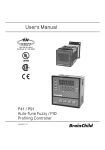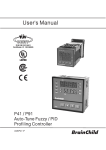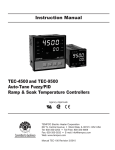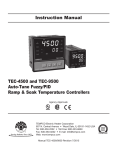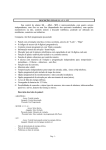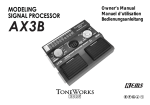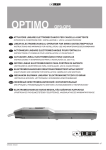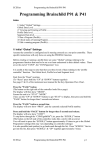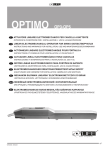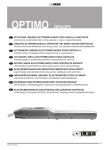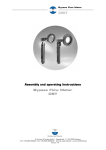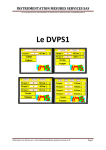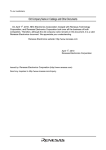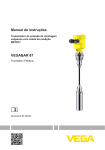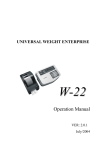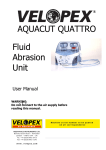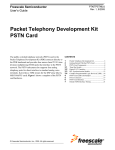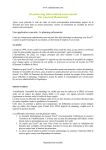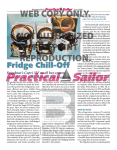Download User`s Manual - Future Design Controls
Transcript
User's Manual DIN EN ISO 9001 Certificate: 01 100 98505 UL R LISTED R B42 Board PID Process/ Temperature Controller UM0B421A Warning Symbol The Symbol calls attention to an operating procedure, practice, or the like, which, if not correctly performed or adhered to, could result in personal injury or damage to or destruction of part or all of the product and system. Do not proceed beyond a warning symbol until the indicated conditions are fully understood and met. Use the Manual Installers Read Chapter 1, 2 System Designer Read All Chapters Expert User Read Page 15,16 NOTE: It is strongly recommended that a process should incorporate a LIMIT CONTROL like L91 which will shut down the equipment at a preset process condition in order to preclude possible damage to products or system. Information in this user's manual is subject to change without This manual is applicable for the products with software version 22 and later version. Copyright a July 2012, The Brainchild Corporation, all rights reserved. No part of this publication may be reproduced, transmitted, transcribed or stored in a retrieval system, or translated into any language in any form by any means without the written permission of the Brainchild Corporation. 2 UM0B421A Contents Page No Chapter 1 Overview 1-1 General ------------------------- 5 1-2 Ordering Code ---------------- 9 1-3 Programming Port ---------- 11 1-4 Keys and Displays ----------12 1-5 Key Operation Flowchart---15 1-6 Parameter Descriptions ----16 Chapter 2 Installation 2-1 2-2 2-3 2-4 2-5 2-6 2-7 Page No Chapter 4 Profiler Operation 4-1 4-2 4-3 4-4 What is set point profiler --- 66 Segment connection ------- 67 Profiler Modes --------------- 67 Running, holding and ---------aborting a profile ----------- 68 4-5 Viewing and modifying -------profile progress ------------ 69 4-6 Start ---------------------------- 69 4-7 Holdback --------------------- 70 4-8 Power failure ----------------- 72 4-9 Configuring the profiler ---- 74 4-10 Viewing and creating a ------profile ------------------------ 74 4-11 Event Outputs and PID ------Selection -------------------- 78 Unpacking -------------------- 31 Mounting --------------------- 31 Wiring precautions --------- 34 Power Wiring ---------------- 36 Sensor Input Wiring -------- 36 Control Output Wiring ----- 36 Alarm /Event Output Wiring ------------------------------------- 40 2-8 Event Input Wiring ---------- 41 2-9 Retransmission Output ----tt Chapter 5 Applications -------79 Wiring ------------------------- 41 2-10 Data Communication ---- 42 Chapter 6 Specifications ---- 81 Chapter 3 Configuration 3-1 Password---------------------- 44 Chapter 7 3-2 Signal Input ------------------ 44 Modbus Communications --- 87 3-3 Event Input ------------------- 45 7-1 Functions Supported ------3-4 Control Outputs ------------- 47 8 7 3-5 Alarms ------------------------- 52 7-2 Exception Responses ------89 3-6 Configure Home Page ----- 56 7-3 Parameter Table ------------3-7 User Calibration ------------- 56 8 9 3-8 Digital Filter ------------------- 58 3-9 Failure Transfer -------------- 59 Chapter 8 3-10 Auto-tuning ----------------- 60 Manual Calibration ----------- 96 3-11 Manual tuning ------------- 61 3-12 Manual Mode -------------- 63 Appendix A-1 ----------------- 98 3-13 Data Communication ---- 63 Appendix A-2 ------------------ 99 3-14 Retransmission ------------ 64 3-15 Output Scaling ------------- 65 UM0B421A 3 Figures & Tables Page No Figure 1.1 Fuzzy Control Advantage ------------------------------------------------------------------------------- 6 Figure 1.2 Programming Port Overview -------------------------------------------------------------------------- 11 Figure 1.3 Front Panel Description ------------------------------------------------------------------------------- 13 Figure 1.4 Program code display --------------------------------------------------------------------------------- 14 Figure 2.1 Dimension of Control Board -------------------------------------------------------------------------- 32 Figure 2.2 Dimension of Display Board--------------------------------------------------------------------------- 33 Figure 2.3 Lead Termination ---------------------------------------------------------------------------------------- 34 Figure 2.4 Rear Terminal Connection -----------------------------------------------------------------------------35 Figure 2.6 Power Supply Connections --------------------------------------------------------------------------- 36 Figure 2.7 Sensor Input Wiring ------------------------------------------------------------------------------------ 36 Figure 2.8 Output 1 Relay or Triac (SSR) to Drive Load ------------------------------------------------------- 36 Figure 2.9 Output 1 Relay or Triac (SSR) to Drive Contactor ------------------------------------------------- 37 Figure 2.10 Output 1 Pulsed Voltage to Drive SSR ------------------------------------------------------------- 37 Figure 2.11 Output 1 Linear Current ------------------------------------------------------------------------------ 38 Figure 2.12 Output 1 Linear Voltage ------------------------------------------------------------------------------ 38 Figure 2.13 Output 2 Relay or Triac (SSR) to Drive Load ------------------------------------------------------38 Figure 2.14 Output 2 Relay or Triac (SSR) to Drive Contactor ----------------------------------------------- 39 Figure 2.15 Output 2 Pulsed Voltage to Drive SSR ------------------------------------------------------------ 39 Figure 2.16 Output 2 Linear Current ------------------------------------------------------------------------------ 39 Figure 2.17 Output 2 Linear Voltage ------------------------------------------------------------------------------ 40 Figure 2.18 Alarm / Event output wiring -------------------------------------------------------------------------- 40 Figure 2.19 Alarm Output to Drive Contactor ------------------------------------------------------------------- 40 Figure 2.20 Event Input wiring ------------------------------------------------------------------------------------- 41 Figure 2.21 Retransmit 4-20 / 0-20 mA Wiring ------------------------------------------------------------------ 41 Figure 2.22 RS-485 Wiring ----------------------------------------------------------------------------------------- 42 Figure 2.23 RS-232 Wiring ------------------------------------------------------------------------------------------43 Figure 2.24 Configuration of RS-232 Cable --------------------------------------------------------------------- 43 Figure 3.1 Conversion Curve for Linear Type Process Value ------------------------------------------------- 45 Figure 3.2 Heat Only ON-OFF Control --------------------------------------------------------------------------- 48 Figure 3.3 Heat - cool Control -------------------------------------------------------------------------------------- 50 Figure 3.4 Process high alarm 1 operation ---------------------------------------------------------------------- 52 Figure 3.5 Process low alarm 1 operation ----------------------------------------------------------------------- 52 Figure 3.6 Deviation high alarm 1 operation -------------------------------------------------------------------- 53 Figure 3.7 Deviation low alarm 1 operation --------------------------------------------------------------------- 53 Figure 3.8 Deviation band alarm 1 operation ------------------------------------------------------------------- 54 Figure 3.9 Two point user calibration ----------------------------------------------------------------------------- 57 Figure 3.10 Filter Characteristics --------------------------------------------------------------------------------- 58 Figure 3.11 Effects of PID Adjustment --------------------------------------------------------------------------- 62 Figure 3.12 Output scaling function ------------------------------------------------------------------------------ 65 Figure 4.1 Set point profile ----------------------------------------------------------------------------------------- 66 Figure 4.2 Holdback operation ------------------------------------------------------------------------------------ 71 Figure 4.3 Recovery from profile at dwell segment ------------------------------------------------------------ 72 Figure 4.4 Recovery from profile at ramp segment -------------------------------------------------------------72 Figure 4.5 Recovery from PV at dwell segment ---------------------------------------------------------------- 73 Figure 4.6 Recovery from PV at ramp segment ---------------------------------------------------------------- 73 Figure 4.7 Profiling curve example -------------------------------------------------------------------------------- 76 Figure 5.1 A Heat Treatment Oven -------------------------------------------------------------------------------- 79 Figure 5.2 Temperature profile of the Heat Treatment Oven --------------------------------------------------80 Table 3.1 Password operation ------------------------------------------------------------------------------------- 44 Table 3.2 Heat-Cool control configuration value --------------------------------------------------------------- 47 Table 3.3 Alarm mode description -------------------------------------------------------------------------------- 55 Table 3.4 PID Adjustment Guide ----------------------------------------------------------------------------------- 61 Table 4.1 Segment types -------------------------------------------------------------------------------------------- 66 Table 4.2 Profiler Modes --------------------------------------------------------------------------------------------- 68 Table 4.3 Parameters that follow segment type ----------------------------------------------------------------- 75 Table 7.1 Exception Code Table ----------------------------------------------------------------------------------- 89 Table 7.2 Number Conversion Table ------------------------------------------------------------------------------ 90 Table A.1 Error Codes and Corrective Actions ------------------------------------------------------------------ 98 4 UM0B421A Chapter 1 Overview 1-1 General The Fuzzy Logic plus PID microprocessor-based profiling controller series, incorporate two bright, easy to read 4-digit LED displays, indicating process value and set point value. The Fuzzy Logic technology enables a process to reach a predetermined set point in the shortest time, with the minimum of overshoot during power-up or external load disturbance. The unit is powered by 11-26 or 90-250 VDC/VAC supply, incorporating a 2 amp. control relay output as standard. The second output can be used as cooling control, an event output or an alarm. Both outputs can select triac, logic output, linear current or linear voltage to drive external device. The units are fully programmable for PT100 and thermocouple types J, K, T, E, B, R, S, N, L, C, P with no need to modify the unit. The input signal is digitized by using a 18-bit A to D converter. Its fast sampling rate allows the unit to control fast processes. There are more functions than the heating and cooling control could be configured for the controller outputs, these include: up to three alarm outputs, up to three event outputs and up to two analog retransmission outputs. Digital communications RS-485 or RS-232 are available as an additional option. These options allow the units to be integrated with supervisory control system and software. A programming port is available for automatic configuration, calibration and testing without the need to access the keys on front panel. By using proprietary Fuzzy modified PID technology, the control loop will minimize the overshoot and undershoot in a shortest time. The following diagram is a comparison of results with and without Fuzzy technology. UM0B421A 5 Temperature PID control with properly tuned PID + Fuzzy control Set point Figure 1.1 Fuzzy Control Advantage Warm Up Load Disturbance Time The series can be configured as a single set point controller (static mode) or a ramp and dwell profiling controller (profile mode). The profile mode feature allows the user to program up to 9 profiles of up to 64 free-format (ramp, dwell, jump or end) segments each. The total segments available for the product is 288 segments. The profiling controllers contain the following features: Flexible Configuration of Program There are up to 64 segments can be defined for a profile. Each segment can be configured as a ramp or a dwell (soak) segment or defining a repeat number of cycles at arbitray location within the profile and finally terminated by an end segment.The user can edit a currently running profile. Maximum Capacity of Program There are at most 9 profiles can be defined and 288 segments totally available for all profiles. The profiles are divide into three kinds of length. The short length profile contains 16 segments, the medium length profile contains 32 segments while the long length profile contains 64 segments at most. Event Input The event input feature allows the user to select one of eight functions: enter profile run mode, enter profile hold mode, abort profile mode, enter manual mode, perform failure transfer, enter off mode, advance to the next segment and select second set of PID values. 6 UM0B421A Programmable Event Outputs Up to three relays are configurable for event outputs and the state of each output can be defined for each segment and end of profile. Analog Retransmission The output5 and output 4 of the products can be equipped with analog output module. The output can be configured for transmitting the process value as well as set point value. High Accuracy The series are manufactured with custom designed ASIC(Application Specific Integrated Circuit ) technology which contains a 18-bit A to D converter for high resolution measurement ( true 0.1 BF resolution for thermocouple and PT100 ) and a 15-bit D to A converter for linear current or voltage control output. The ASIC technology provides improved operating performance, low cost, enhanced reliability and higher density. Fast Sampling Rate The sampling rate of the input A to D converter reaches 5 times/second. The fast sampling rate allows this series to control fast processes. Fuzzy Control The function of Fuzzy control is to adjust PID parameters from time to time in order to make manipulation output value more flexible and adaptive to various processes. The results is to enable a process to reach a predetermined set point in the shortest time, with the minimum of overshoot and undershoot during power-up or external load disturbance. Digital Communication The units are equipped with RS-485 or RS-232 interface card to provide digital communication. By using the twisted pair wires there are at most 247 units can be connected together via RS-485 interface to a host computer. UM0B421A 7 Programming Port A programming port is used to connect the unit to a hand-held programmer or a PC for quick configuration, also can be connected to an ATE system for automatic testing & calibration. Auto-tune The auto-tune function allows the user to simplify initial setup for a new system. A clever algorithm is provided to obtain an optimal set of control parameters for the process, and it can be applied either as the process is warming up ( cold start ) or as the process has been in steady state ( warm start ). Lockout Protection According to actual security requirement, a password is provided to prevent the unit from being changed abnormally. Bumpless Transfer Bumpless transfer allows the controller to continue to control by using its previous value as the sensor breaks. Hence, the process can be well controlled temporarily as if the sensor is normal. Digital Filter A first order low pass filter with a programmable time constant is used to improve the stability of process value. This is particularly useful in certain application where the process value is too unstable to be read. SEL Function The units have the flexibility for user to select those parameters which are most significant to him and put these parameters in the home page. There are at most 8 parameters can be selected to allow the user to build his own display sequence. 8 UM0B421A 1-2 Ordering Code B42Display Board and cable Power Input 0: None 3: Display Board with 300mm connection cable 4: Display Board with 1000mm connection cable 4: 90 - 250 VAC, 47-63 Hz 5: 11 - 26 VAC or VDC, Signal Input Output 5 1: Standard Input Thermocouple: J, K, T, E, B, R, S, N, L, C, P RTD: PT100 DIN, PT100 JIS Voltage: 0-60mV 5: 0-10V, 0-1V, 0-5V, 1-5V 6: 0-20/4-20 mA 9: Special Order 0: None 3: Retransmit 4 - 20mA / 0 - 20mA 4: Retransmit 1 - 5V / 0 - 5V/0 - 10V 7: Isolated 20V/25mA transducer power supply 8: Isolated 12V/40mA transducer power supply A: Isolated 5V/80mA transducer power supply D: Isolated RS-485 interface E: Isolated RS-232 interface Output 1 0: None 1: Relay rated 2A/240VAC 2: Pulsed voltage to drive SSR, 5V/30mA 3: Isolated 4 - 20mA / 0 - 20mA 4: Isolated 1 - 5V / 0 - 5V/0 - 10V 6: Triac output 1A / 240VAC,SSR C: Pulsed voltage to drive SSR, 14V/40mA 9: Special order Output 4 Output 2 0: None 1: Relay rated 2A/240VAC 2: Pulsed voltage to drive SSR, 5V/30mA 3: Isolated 4 - 20mA / 0 - 20mA 4: Isolated 1 - 5V / 0 - 5V/0 - 10V 6: Triac output 1A / 240VAC,SSR 7: Isolated 20V/25mA transducer power supply 8: Isolated 12V/40mA transducer power supply A: Isolated 5V/80mA transducer power supply C: Pulsed voltage to drive SSR, 14V/40mA 9: Special order 0: None 1: Relay rated 2A/240VAC 2: Pulsed voltage to drive SSR, 5V/30mA 3: Retransmit 4 - 20mA / 0 - 20mA 4: Retransmit 1 - 5V / 0 - 5V/0 - 10V 6: Triac output 1A / 240VAC,SSR 7: Isolated 20V/25mA transducer power supply 8: Isolated 12V/40mA transducer power supply A: Isolated 5V/80mA transducer power supply C: Pulsed voltage to drive SSR, 14V/40mA 9: Special order Output 3 0: None 1: Relay rated 2A/240VAC 2: Pulsed voltage to drive SSR, 5V/30mA 6: Triac output 1A / 240VAC,SSR 7: Isolated 20V/25mA transducer power supply 8: Isolated 12V/40mA transducer power supply A: Isolated 5V/80mA transducer power supply C: Pulsed voltage to drive SSR, 14V/40mA 9: Special order UM0B421A 9 Accessories OM94-6 = Isolated 1A / 240VAC Triac Output Module ( SSR ) OM94-7 = 14V / 40mA SSR Drive Module OM98-3 = Isolated 4 - 20 mA / 0 - 20 mA Analog Output Module OM98-5 = Isolated 0 -10V Analog Output Module CM94-1 = Isolated RS-485 Interface Module for Output 5 CM94-2 = Isolated RS-232 Interface Module for Output 5 CM94-3 = Isolated 4-20mA/0-20mA Retrans Module for Output 5 CM94-5 = Isolated 0-10V Retrans Module for Output 5 DC94-1 = Isolated 20V/25mA DC Output Power Supply DC94-2 = Isolated 12V/40mA DC Output Power Supply DC94-3 = Isolated 5V/80mA DC Output Power Supply CC94-1 = RS-232 Interface Cable ( 2M ) CC91-2 = Programming Port Cable DC21-1 = Isolated 20V/25mA DC Output Power Supply for Output 5 DC21-2 = Isolated 12V/40mA DC Output Power Supply for Output 5 DC21-3 = Isolated 5V/80mA DC Output Power Supply for Output 5 10 UM0B421A 1-3 Programming Port N L 90-250VAC AO AO+ TX2 TX1 TE6 BS0B421A pin1 TE2 EI PTB PTB PTA TC TC+ RY31 TE5 C+ NO OP4 TE8 M32 TE4 NO NC OP3 TE7 M31 C+ EI+ TE3 C+ NO OP2 Programming Port OM51 CN54 C+ NO OP1 CN51 TE1 COM CN52 Figure 1.2 Programming Port Overview A special connector can be used to touch the programming port which is connected to a PC for automatic configuration, also can be connected to an ATE system for automatic calibration and testing. The programming port is used for off-line automatic setup and testing procedures only. Don't attempt to make any connection to these pins when the unit is used for a normal control purpose. UM0B421A 11 1- 4 Keys and Displays KEYPAD OPERATION SCROLL KEY : This key is used to select a parameter to be viewed or adjusted. UP KEY : This key is used to increase the value of selected parameter. DOWN KEY : This key is used to decrease the value of selected parameter. PAGE KEY: This key is used to select desired page of parameters. REVERSE SCROLL : Press both and keys to jump to the previous parameter. RESET KEY : Press both and keys to : 1. Revert the display to display the process value. 2. Reset the latching alarm, once the alarm condition is removed. 3. Stop the manual control mode , auto-tuning mode and off mode, then enters the static mode. 4. Clear the message of communication error, holdback time out error and auto-tuning error. 5. To reset new profile start segment to 1.00 after earlier profile is completed when " RUN" and "HLD" LED's are blinking together. ENTER KEY : Press for 5 seconds to : 1. Enter the selected mode to run. 2. Execute calibration procedure for the low point and high point calibration. 12 UM0B421A Output Status indicators for output1~output 4 Upper Display, to display process value, menu symbol and error code etc. Lower Display, to display set point value, parameter value or control output value etc. PV On : profile running Flashing: profile in delayed state LC Out1 LF Out2 RUN Out3 HLD Out4 SV On : profile held Flashing: profile in holdback state : Running ramp up segment : Running ramp down segment : Running dwell segment Both off : profile held or in static mode B42 4 Buttons for ease of control setup and set point adjustment. Figure 1.3 Front Panel Description PV LC Out1 LF Out2 RUN Out3 HLD Out4 SV The unit will display the program code for 2.5 seconds during power up. The display shows program number 37 with program version 22. The program no.37. B42 Figure 1.4 Program code display UM0B421A 13 1-5 Key Operation Flowchart Home Page Home Display Mode Page Profile Page (MODE) ( 1-9 ) PV SV (Profile run mode) PV (Profile hold mode) (Static mode) (Automatic tuning PID1 mode) TIME (Automatic tuning PID2 mode) (Manual mode) CYCL PV (Off mode) Using / key to select desired mode, then 5sec. Enters the selected mode HBBD STSP RMPU DLLU SGNO SGTY PV PASS ASP1 ASP2 ASP3 INPT UNIT DP PB1 TI1 TD1 CYC1 DLAY TGSP RT or RR P2EV HB DLLT P2EV HB SEG CYCL SGNO SGTY FSP CYCL TGSP RT or RR P2EV HB DLLT P2EV HB SEG CYCL SGNO SGTY 14 UM0B421A FSP CYCL Low Calibration Page Configuration Page 5 sec. 5 sec. INPT UNIT DP INLO INHI FILT EIFN SPLO SPHI OUT1 O1FT O1HY CYC1 OP1L OP1H PB1 TI1 TD1 PB2 TI2 TD2 OFST OUT2 O2FT CYC2 CPB DB OP2L OP2H OUT3 O3FT OUT4 O4FT OP4L OP4H REL4 REH4 OUT5 OP5L OP5H REL5 REH5 ADDR BAUD PARI ALF1 A1MD A1HY High Calibration Page (CALO) (CAHI) PV (OFSTL) PV (OFSTH) Using or key to adjust the offset low value (lower display) until the process value (higher display) is equal to the required value, then Using or key to adjust the offset high value (lower display) until the process value (higher display) is equal to the required value, then 5 sec. 5 sec. Complete calibration procedure for the low point calibration. Complete calibration procedure for the high point calibration. ALF2 A2MD A2HY ALF3 A3MD A3HY SEL1 SEL2 SEL3 SEL4 SEL5 SEL6 SEL7 SEL8 CODE STAR END DLAY PFR HBT INPT UM0B421A 15 1-6 Parameter Descriptions Register Parameter Parameter Description Address Notation 0 1 SP1 PFSG 4 5 6 7 Low: SPLO High: SPHI Low: 1.00 Indicate the current Profile/Segment number Profile number Segment number Time remaining for the current segment Low: 00.00 High: 99.59 CYCL cycle remaining for the current profile Low: 1 High: 9999 10000=infinite Password entry Low: 0 High: 9999 Set point for alarm 1 PASS ASP1 ASP2 ASP3 Default Value Data type 25.0 BC (77.0 BF) R/W 1.00 R/W High: 9.63 TIME 2 3 Controller (Static mode) Set point value Range R/W R 1 R/W Low: -32768 High: 32767 10.0 BC (18.0 BF) R/W Set point for alarm 2 Low: -32768 High: 32767 10.0 BC (18.0 BF) R/W Set point for alarm 3 Low: -32768 High: 32767 10.0 BC (18.0 BF) R/W 1 (0) R/W (T/C=thermocouple) 8 INPT Input sensor selection 0 1 : J type T/C 2 : T type T/C 3 : E type T/C 4 : B type T/C 5 : R type T/C 6 : S type T/C 7 : N type T/C 8 : L type T/C 9 : C type T/C 10 : P type T/C 11 12 16 UM0B421A : K type T/C : PT 100 ohms DIN curve : PT 100 ohms JIS curve Register Parameter Address Notation 8 9 10 11 12 13 INPT UNIT DP MODE Parameter Description Input sensor selection Input unit selection Decimal point selection Operation mode Range 13 : 4 - 20 mA linear current input 14 : 0 - 20 mA linear current input 15 : 0 - 60 mV linear millivolt input 16 : 0 - 1V linear voltage input 17 : 0 - 5V linear voltage input 18 : 1 - 5V linear voltage input 19 : 0 - 10V linear voltage input 0 : Degree C unit 1 : Degree F unit 2 : Process unit 0 : No decimal point 1 : 1 decimal digit 2 : 2 decimal digits 3 : 3 decimal digits 0 :Profile run mode 1 :Profile hold mode 2 :Static mode 3 :Automatic tuning PID1 mode 4 : Automatic tuning PID2 mode 5 :Manual mode 6 :Off mode INLO Input low scale value Low: -32768 High: INHI-50 INHI Input high scale value Low: INLO+50 High: 32767 UM0B421A Default Value Data type 1 (0) R/W 0 (1) R/W 1 R/W 0 R/W -17.8 LC ( 0 LF ) R/W 93.3 LC (200.0 LF) R/W 17 Register Parameter Address Notation FILT 14 15 16 17 EIFN Parameter Description Filter damping time constant of PV Event input function Range 0 : 0 second time 1 : 0.2 second time 2 : 0.5 second time 3 : 4 : 5 : 6 : 7 : 8 : 9 : 2 R/W 0 R/W constant constant 1 second time constant 2 seconds time constant 5 seconds time constant 10 seconds time constant 20 seconds time constant 30 seconds time constant 60 seconds time constant : No function 1 : Program run mode 2 : Program hold mode 3 : Abort profile mode 4 : Manual mode 5 : Failure Transfer 6 : Off mode 7 : Pass to the next segment 8 : Select PB2 TI2 & TD2 for control SPLO Low limit of set point value Low: -32768 High: SPHI -17.8 LC (0 LF) R/W SPHI High limit of set point value Low: SPLO High: 32767 537.8 LC (1000 LF) R/W 3 R/W OUT1 Output 1 function 3 4 5 6 18 Data type constant 0 0 1 2 18 Default Value : No function : Heating on-off control : Heating time proportioning control : Heating linear control : Cooling on-off control : Cooling time proportioning control : Cooling linear control UM0B421A Parameter Description Range Default Value Data type O1FT Output 1 failure transfer status Select BPLS ( bumpless transfer ) or 0.0 ~ 100.0 % to continue output 1 control function as the unit fails, or select OFF (0) or ON (1) for ON-OFF control. 0 R/W O1HY Output 1 ON-OFF control hysteresis Low: 0.1 High:50.0 BC(90.0BF) 0.1LC (0.2 LF) R/W CYC1 Output 1 cycle time Low: 0.1 High: 90.0 sec. 18.0 R/W OP1L Low limit value for output 1 Low: 0 High: 100.0 % 0 R/W OP1H High limit value for output 1 Low: 0 High: 120.0 % 100.0 R/W PB1 Proportional band value 1 Low: 0 500.0 LC High: (900.0 LF) 10.0 LC (18.0 LF) R/W TI1 Integral time value 1 Low: 0 High: 3600 sec 100 R/W TD1 Derivative time value 1 Low: 0 High: 900.0 sec 25.0 R/W PB2 Proportional band value 2 Low: 0 500.0 LC High: (900.0 LF) 10.0 LC (18.0 LF) R/W TI2 Integral time value 2 Low: 0 High: 3600 sec 100 R/W TD2 Derivative time value 2 Low: 0 High: 900.0 sec 25.0 R/W OFST Offset value for P control (TI=0) Low : 0.0 High : 100.0% 25.0 R/W 3 R/W Register Parameter Address Notation 19 20 21 22 23 24 25 26 27 28 29 30 31 Reserved 32 Reserved 33 OUT2 Output 2 function 0 1 : No function : Cooling time proportioning control 2 : Cooling linear control 3 : Alarm 1 output 4 : Reverse alarm 1 Output 5 : Event 1 output 6 : DC power supply output UM0B421A 19 Register Parameter Address Notation 34 35 36 37 38 39 Parameter Description O2FT Output 2 failure transfer status CYC2 Output 2 cycle time CPB Cooling proportional band value Heating-cooling dead band (negative value= overlap) DB Select BPLS ( bumpless transfer ) or 0.0 ~ 100.0 % to continue output 2 control function as the unit fails, or select OFF (0) or ON (1) for alarm or event output. R/W Low: 0.1 High: 90.0 sec. 18.0 R/W Low: 50 High: 300 % 100 R/W Low: -36.0 High: 36.0 % 0 R/W High: 100.0 % 0 R/W OP2H High limit value for output 2 Low: 0 High: 120.0 % 100.0 R/W 3 R/W 0 R/W 3 R/W Reserved OUT3 Output 3 function 0 1 2 : No function : Alarm 2 output : Reverse alarm 2 output : Event 2 output : DC power supply output : Output 3 OFF as unit fails : Output 3 ON as unit fails 3 4 O3FT OUT4 Output 3 failure transfer status Output 4 function 0 1 0 1 : No function : Alarm 3 output 2 : Reverse alarm 3 output 3 : Event 3 output 4 : Retransmit process value : Retransmit set point value 5 6 20 0 Low: 0 41 44 Data type Low limit value for output 2 Reserved 43 Default Value OP2L 40 42 Range UM0B421A : DC power supply output Register Parameter Address Notation 45 46 47 48 49 O4FT Output 4 failure transfer status Default Value Data type : Output 4 OFF as unit fails : Output 4 ON as unit fails 0 R/W Low: 0 High: 100.0 % 0 R/W Low: 0 High: 120.0 % 100.0 R/W Range 0 1 OP4L Low limit value for output 4 OP4H High limit value for output 4 Retransmission REL4 low scale value for output4 REH4 50 51 Parameter Description Retransmission high scale value for output4 Low: -32768 High:32767 0.0 BC (32.0BF) R/W Low: -32768 High:32767 10 0.0 BC (212.0BF) R/W Reserved OUT5 0 1 2 Output 5 function 3 4 52 53 56 0 R/W OP5L Low limit value for output 5 Low: 0 High: 100.0 % 0 R/W OP5H High limit value for output 5 Low: 0 High: 120.0 % 100.0 R/W REL5 Retransmission low scale value for output 5 Low: -32768 High:32767 0.0 BC (32.0BF) R/W Retransmission high scale value for output 5 Low: -32768 High:32767 10 0.0 BC (212.0BF) R/W Address assignment of digital communication Low: 1 54 55 : No function : Communication port : Retransmit process value : Retransmit set point value : DC power supply output REH5 ADDR UM0B421A High: 247 1 R/W 21 Register Parameter Address Notation BAUD 57 58 59 60 PARI ALF1 A1MD Parameter Description Range 0 : 2.4 Kbits/s baud rate 1 : 4.8 Kbits/s baud rate Baud rate of digital 2 communication 3 : 9.6 Kbits/s baud rate Parity bit of digital communication Alarm 1 function : 19.2 Kbits/s baud rate 5 : 28.8 Kbits/s baud rate 6 : 38.4 Kbits/s baud rate 0 : Even parity 1 : Odd parity 2 : No parity bit 0 : Process high alarm 1 : Process low alarm 2 : Deviation high alarm 3 : Deviation low alarm 4 : Deviation band high/low alarm 5 : End of profile alarm 6 : Hold mode alarm 7 : Static mode alarm 0 : Normal alarm action 3 61 22 A1HY Hysteresis control for alarm 1 Data type 2 R/W 0 R/W 2 R/W : 14.4 Kbits/s baud rate 4 1 Alarm 1 operation mode 2 Default Value : Latching alarm action : Hold alarm action 0 R/W : Latching & hold alarm action Low: 0.1 UM0B421A High: 50.0 LC (90.0 LF) 0.1 LC (0.2 LF) R/W Register Parameter Address Notation 62 63 ALF2 A2MD Parameter Description Range 0 : Process high alarm 1 : Process low alarm 2 : Deviation high alarm 3 : Deviation low alarm 4 : Deviation band high/low alarm 5 : End of profile alarm 6 : Hold mode alarm 7 : Static mode alarm 0 : Normal alarm action Alarm 2 function 1 Alarm 2 operation mode 2 3 64 A2HY 65 66 67 Hysteresis control for alarm 2 Default Value Data type 2 R/W 0 R/W 0.1 LC (0.2 LF) R/W 2 R/W 0 R/W : Latching alarm action : Hold alarm action : Latching & hold alarm action High: 50.0 LC (90.0 LF) Low: 0.1 Reserved ALF3 A3MD Alarm 3 function Alarm 3 operation mode 0 : Process high alarm 1 : Process low alarm 2 : Deviation high alarm 3 : Deviation low alarm 4 : Deviation band high/low alarm 5 : End of profile alarm 6 : Hold mode alarm 7 : Static mode alarm 0 : Normal alarm action 1 : Latching alarm action 2 : Hold alarm action 3 : Latching & hold alarm action UM0B421A 23 Register Parameter Address Notation 68 A3HY 69 Parameter Description Hysteresis control for alarm 3 Range Low: 0.1 : No parameter selected : INPT selected for home page : UNIT selected for home page : DP selected for home page : PB1 selected for home page : TI1 selected for home page : TD1 selected for home page : PB2 selected for home page : TI2 selected for home page : TD2 selected for home page : OFST selected for home page : O1HY selected for home page : CYC1 selected for home page : CYC2 selected for home page : CPB selected for home page : DB selected for home page : A1HY selected for home page : A2HY selected for home page : A3HY selected for home page : DLAY Selected for home page : Manual event output 1 2 3 4 5 6 7 8 SEL1 70 Select 1'st parameter for home page 9 10 11 12 13 14 15 16 17 18 19 20 72 24 Data type 0.1 LC (0.2 LF) R/W 0 R/W Reserved 0 71 High: 50.0 LC (90.0 LF) Default Value SEL2 Select 2'nd parameter for home page Same as SEL1 0 R/W SEL3 Select 3'rd parameter for home page Same as SEL1 0 R/W UM0B421A Register Parameter Address Notation 73 74 75 76 77 78 Parameter Description Range Same as SEL1 0 R/W Select 5'th parameter for home page Same as SEL1 0 R/W SEL6 Select 6'th parameter for home page Same as SEL1 0 R/W SEL7 Select 7'th parameter for home page Same as SEL1 0 R/W SEL8 Select 8'th parameter for home page Same as SEL1 0 R/W 0 R/W 0 R/W 0 R/W 0 R/W SEL5 CODE Security code for parameter protection Low: 0 High: 9999 0=unprotected 1000= home page unprotected Reserved 0 STAR Set point value at start of each profile 1 2 81 END Set point value at end of each profile DLAY Delay time ( hours /minutes) between profile initiation and profile start : Current process value PV : Controller set point value SP1 : Start set point value STSP 0 : Final set point value for each program 1 : Controller set point value : All outputs go to off execpt end of profile relay 2 82 Data type Select 4'th parameter for home page SEL4 79 80 Default Value Low : 0.00 UM0B421A High : 99.59 25 Register Parameter Address Notation 83 84 PFR HBT Parameter Description Power fail recovery Holdback wait time Default Value Data type 2 R/W High : 99.59 (hour.minute) : infinite 1.00 R/W Low: 1 High: 9 1 R/W Low: 1 High: 555 LC (999LF) R/W Low : SPLO High : SPHI R/W Range 0 : Continue profile from the last set point value 1 : Start to run from PV 2 : Static mode, SP1 3 : OFF mode Low : 0.00 0.00= 85 86 87 88 89 90 91 92 93 26 Reserved PROF HBBD STSP RMPU DLLU SGNO SGTY TGSP Profile number selected for view Holdback band Start set point value Unit for ramp segment Unit for dwell segment 0 : Hours. Minutes 1 : Minutes. Seconds 2 : units per minute 3 : units per hour 0 : Hours. Minutes 1 : Minutes. Seconds Segment number Low : 0 High:15(PROF=1~4) 31(PROF=5~7) 63(PROF=8,9) Segment type for the selected segment number 0 1 2 3 Target set point for ramp segment : Ramp : Dwell : Jump : End Low : SPLO UM0B421A High : SPHI R/W R/W R/W 3 R/W R/W Register Parameter Address Notation 94 95 96 97 98 99 100 RTRR P2EV HBTY Parameter Description Time duration or Ramp rate for ramp segment Holdback type Duration time for dwell segment SEG Target segment number for the jump segment FSP Low: 0 High: 5999 Repeat number of cycles for the jump and end segment Final set point for the end segment 0. 1. : Holdback disabled : Deviation low holdback 2. : Deviation high holdback 3. : Deviation band holdback Low: 0 R/W R/W High: 99.59 R/W Low : 0 High:15(PROF=1~4) 31(PROF=5~7) 63(PROF=8,9) Low: 1 High: 9999 10000 = : infinite Low: SPLO High: SPHI Data type R/W Four-bit binary number States assignment ( 0=inactive 1=active ) of PID selection and event outputs Event 1 for ramp, and Event 2 dwell segment. Event 3 PID 2 DLLT CYCL Default Value Range R/W R/W R/W 101 Offset value for OFSTL low point calibration Low: -1999 high: 1999 0 R/W 102 Offset value for OFSTH high point calibration Low: -1999 high: 1999 0 R/W 103 ADLO mV calibration low coefficient Low: -1999 high: 1999 R/W 104 ADHI Low: -1999 high: 1999 R/W mV calibration high coefficient UM0B421A 27 Register Parameter Address Notation Parameter Description Range Default Value Data type 105 RTDL RTD calibration low coefficient Low: -1999 high: 1999 R/W 106 RTDH RTD calibration high coefficient Low: -1999 high: 1999 R/W CJLO Cold junction calibration low coefficient Low: -5.00 high: 40.00 R/W 108 CJHI Cold junction calibration high coefficient Low: -1999 high: 1999 R/W 109 DATE Date code 110 SRNO Serial number 107 111 Low: 0 High: 3719 (9C31) R/W Low: 0 High: 9999 R/W Reserved 112 BPL1 Bumpless transfer value of MV1 Low: 0 High: 100.00 R 113 BPL2 Bumpless transfer value of MV2 Low: 0 High: 100.00 R 114 CJCL Sense voltage durig cold junction calibration low Low: 0 High: 7552 R CALO Input signal value during low point calibration Low: -32768 High: 32767 0 R 116 CAHI Input signal value during high point calibration Low: -32768 High: 32767 1000 R 117 CAIN Input sensor calibrated Low: 0 High: 20 20 R 115 118 Reserved 119 Reserved 120 Reserved 121 Reserved 122 Reserved 28 UM0B421A Register Parameter Address Notation Parameter Description 123 Reserved 124 Reserved 125 Reserved 126 Reserved 127 MAEO Manual event output Default Value Range Low: 000 High: 111 Data type R/W 128 PV Process value Low: -32768 High: 32767 R 129 SV Set point value for control Low: SPLO High: SPHI R Output 1 percentage value (Heating ) Low: 0.00 High: 100.00 *1 Output 2 percentage value (Cooling ) Low: 0.00 High: 100.00 *1 130 131 MV1 MV2 Mode and operation status word Bit 0 = Profile run mode Bit 1 = Profile hold mode Bit 2 = Static mode Bit 3 = Automatic tuning mode Bit 4 = Manual mode Bit 5 = Off mode Bit 6 = Failure mode Bit 7 = Profile running up Bit 8 = Profile runing down Bit 9 = Profile soaking Bit 10 = Alarm 1 active Bit 11 = Alarm 2 active Bit 12 = Alarm 3 active Bit 13 = Event 1 on Bit 14 = Event 2 on Bit 15 = Event 3 on 132 STAT 133 EROR Error Code Low: 0 134 PFSG Current profile and segment runing Low: 1.00 High: 9.63 R 135 TNSG Total number of segments Low: 1 High: 64 R 136 TTSG Total time for segment runing Low: 0 High: 99.59 R UM0B421A High: 40 R R 29 Register Parameter Address Notation Parameter Description Default Value Range Data type SPSG Set point for current segment Low:SPLO High: SPHI R TIME Time remaining for the current segment Low:00.00 High: 99.59 R 139 CYCL Cycle remaining for the current loop Low:1 High: 9999 10000=infinite R 140 PROG Program and version code of the product Low: -32768 High: 32767 R 141 HBTR Holdback time remaning for the current segment Low: 0 High: 99.59 R 142 CMND Command code Low: -32768 High: 32767 R/W 143 JOB Job code Low: -32768 High: 32767 R/W 137 138 *1 Read only unless in manual control mode. 30 UM0B421A Chapter 2 Installation Dangerous voltages capable of causing death are sometimes present in this instrument. Before installation or beginning any cleaning or troubleshooting procedures the power to all equipment must be switched off and isolated. Units suspected of being faulty must be disconnected and removed to a properly equipped workshop for testing and repair. Component replacement and internal adjustments must be made by a qualified maintenance person only. This instrument is protected throughout by Double Insulation -. To minimize the possibility of fire or shock hazards, do not expose this instrument to rain or excessive moisture. Do not use this instrument in areas under hazardous conditions such as excessive shock, vibration, dirt, moisture, corrosive gases or oil. The ambient temperature of the areas should not exceed the maximum rating specified in Chapter 6. Remove stains from this instrument using a soft, dry cloth. Don't use harsh chemicals, volatile solvent such as thinner or strong detergents to clean the instrument in order to avoid deformation or discoloration. 2-1 Unpacking Upon receipt of the shipment remove the unit from the carton and inspect the unit for shipping damage. If any damage due to transit , report and claim with the carrier. Write down the model number, serial number, and date code for future reference when corresponding with our service center. The serial number (S/N) and date code (D/C) are labeled on the box and the housing of control. 2-2 Mounting Make panel cutout to dimension shown in Figure 2.1. Take both mounting clamps away and insert the controller into panel cutout. Install the mounting clamps back. Gently tighten the screws in the clamp till the controller front panels is fitted snugly in the cutout. UM0B421A 31 Figure 2.1 Dimension of Control Board 45.0 0.0 6.40 46.9 45.0 50.0 L N 45.0 45.0 32.0 26.8 13.0 9.25 11.8 0.0 0.0 12.9 15.9 TX1 TX2 COM TC+ TC- 33.5 CN51 45.0 45.0 50.0 pin1 50.0 45.0 37.0 0.0 45.0 50.0 4.0(4) Programming Port 21.0 21.0 16.0 13.8 0.0 1.6 32 UM0B421A 8.30 +0.30 0.00 40.00 33.00 35.00 29.30 0.00 9.50 16.00 21.30 32.00 35.00 40.00 Figure 2.2 Dimension of Display Board 1.60 35.00 DL1 30.00 DL2 24.50 DL9 DL8 DL10 DL7 15.50 30.00 29.75 24.50 15.50 DL3 DL11 5.00 DL4 DL5 DL15 DL13 0.00 3.00 10.50 7.50 DL6 0.00 DL12 DL16 DL14 5.50 20.00 30.00 30.00 35.00 UM0B421A 32.00 35.00 17.00 2.00 13.00 35.00 4.00(4) 33 2 - 3 Wiring Precautions * Before wiring, verify the label for correct model number and options. Switch off the power while checking. * Care must be taken to ensure that maximum voltage rating specified on the label are not exceeded. * It is recommended that power of these units to be protected by fuses or circuit breakers rated at the minimum value possible. * All units should be installed inside a suitably grounded metal enclosure to prevent live parts being accessible from human hands and metal tools. * All wiring must conform to appropriate standards of good practice and local codes and regulations. Wiring must be suitable for voltage, current, and temperature rating of the system. * Beware not to over-tighten the terminal screws. The torque should not exceed 1 N-m ( 8.9 Lb-in or 10.2KgF-cm ). * Unused control terminals should not be used as jumper points as they may be internally connected, causing damage to the unit. * Verify that the ratings of the output devices and the inputs as specified in Chapter 6 are not exceeded. * Except the thermocouple wiring, all wiring should use stranded copper conductor with maximum gauge 18 AWG. 2.0mm 0.08" max. Figure 2.3 Lead Termination 4.5 ~7.0 mm 0.18" ~0.27" 34 UM0B421A EI+ TE3 C+ NO NC OP3 TE4 EI TE2 C+ NO OP2 TE5 C+ NO OP4 35 UM0B421A PTB PTB PTA TC TC+ COM TE1 C+ NO OP1 TE7 AO AO+ TX2 TX1 N L 90-250VAC TE8 TE6 BS0B421A Figure 2.4 Terminal Connection 2 - 4 Power Wiring TE1 L N Fuse 1 2 90 ~ 250 VAC or 11 ~ 26 VAC / VDC 2A/250VAC Figure 2.6 Power Supply Connections 2-5 Sensor Input Wiring TE8 V + + RTD + 3 2 1 PTA TC+, V+ PTB, mA+ TC-, VPTB, mA- A B _ B _ _ TC V mA RTD Figure 2.7 Sensor Input Wiring 2-6 Control Output Wiring + TE2 _ 1 2 LOAD 120V/240VAC Mains Supply Figure 2.8 Output 1 Relay or Triac (SSR) to Drive Load 36 UM0B421A + TE2 _ 1 2 120V /240V Mains Supply Three Phase Delta Heater Load Contactor No Fuse Breaker Three Phase Heater Power Figure 2.9 Output 1 Relay or Triac (SSR) to Drive Contactor SSR Load + _ 1 2 + + TE2 _ 120V /240V Mains Supply _ Internal Circuit 30mA / 5V Pulsed Voltage 5V 33 + 33 0V Figure 2.10 Output 1 Pulsed Voltage to Drive SSR UM0B421A 37 1 2 + TE2 0 - 20mA, 4 - 20mA Load _ Maximum Load 500 ohms Figure 2.11 Output 1 Linear Current 1 2 + TE2 0 - 1V, 0 - 5V 1 - 5V, 0 - 10V Load _ Minimum Load 10 K ohms Figure 2.12 Output 1 Linear Voltage TE3 1 2 LOAD 120V/240VAC Mains Supply Figure 2.13 Output 2 Relay or Triac (SSR) to Drive Load 38 UM0B421A + _ TE3 1 2 120V /240V Mains Supply Three Phase Delta Heater Load Contactor No Fuse Breaker Three Phase Heater Power Figure 2.14 Output 2 Relay or Triac (SSR) to Drive Contactor SSR Load + 1 2 + TE3 _ 120V /240V Mains Supply _ Internal Circuit 30mA / 5V Pulsed Voltage 5V 33 + 33 0V Figure 2.15 Output 2 Pulsed Voltage to Drive SSR 1 2 + TE3 0 - 20mA, 4 - 20mA Load _ Maximum Load 500 ohms Figure 2.16 Output 2 Linear Current UM0B421A 39 1 2 + TE3 0 - 1V, 0 - 5V 1 - 5V, 0 - 10V Load _ Minimum Load 10 K ohms Figure 2.17 Output 2 Linear Voltage 2-7 Alarm / Event Output Wiring TE3 TE4 TE5 out2 out3 Out4 1 2 1 2 3 1 2 LOAD 120V/240VAC Mains Supply Figure 2.18 Alarm / Event output wiring TE3 TE4 TE5 out2 out3 Out4 1 2 1 2 3 1 2 120V /240V Mains Supply Three Phase Heater Power No Fuse Three Phase Contactor Breaker Delta Heater Load Relay Output to Drive Contactor Figure 2.19 Alarm Output to Drive Contactor 40 UM0B421A 2-8 Event Input Wiring TE7 2 1 EI switch Figure 2.20 Event Input wiring 2-9 Retransmission Output Wiring TE6 3 2 + LOAD Minimum Load 10K ohms for voltage Maximum Load 500 ohm for current Figure 2.21 Retransmit 4-20 / 0-20 mA Wiring UM0B421A 41 2-10 Data Communication TE6 TX1 TX2 3 2 RS-485 to RS-232 network adaptor TX1 TX2 SNA10A or SNA10B RS-232 Twisted-Pair Wire TX1 TX2 TE6 TX1 TX2 3 2 TX1 TX2 Max. 247 units can be linked TE6 TX1 TX2 3 2 TX1 TX2 Terminator 220 ohms / 0.5W Figure 2.22 RS-485 Wiring 42 UM0B421A PC RS-232 TE6 TXD RXD COM PC 3 2 1 9-pin RS-232 port CC94-1 Figure 2.23 RS-232 Wiring If you use a conventional 9-pin RS-232 cable instead of CC94-2, the cable must be modified according to the following circuit diagram. To DTE ( PC ) RS-232 Port 1 TE6 TXD RXD COM 3 2 1 TX1 RD TX2 TD 2 3 4 COM GND 6 7 8 9 5 Female DB-9 1 DCD 2 RD 3 TD 4 DTR 5 GND 6 DSR 7 RTS 8 CTS 9 RI Figure 2.24 Configuration of RS-232 Cable UM0B421A 43 Chapter 3 Configuration The parameters stored in Home page can be obtained by pressing scroll key . The parameters stored in Configuration page are obtained by pressing page key 2 times until the display shows , then press page key for at least 5 seconds and release to show - the Configuration page, then press scroll key to get the configuration parameter. The upper display indicates the parameter symbol, and the lower display indicates the selected value of parameter. 3-1 Password There are two parameters which specity the data security function, these are PASS ( password ) and CODE ( security code ). Value of CODE 0 Any value =1000 1000 Results Value of PASS All parameters are changeable All parameters are changeable =1000 Only Home page parameters are changeable =CODE All parameters are changeable =CODE All parameters are not changeable Others Table 3.1 Password operation 3-2 Signal Input INPT: Selects the sensor type or signal type for signal input. Range: ( thermocouple ) J_TC, K_TC, T_TC, E_TC, B_TC, R_TC S_TC, N_TC, L_TC, C_TC, P_TC. ( RTD ) PT.DN, PT.JS (linear ) 4-20, 0-20, 0-60, 0-1V, 0-5V, 1-5V, 0-10 UNIT: Selects the process unit Range: C, F, PU( process unit ). If the unit is neither C nor F, then selects PU. DP: Selects the resolution of process value. Range: ( for T/C and RTD ) NO.DP, 1-DP (for linear ) NO.DP, 1-DP, 2-DP, 3-DP INLO: Selects the low scale value for the linear type input. INHI : Selects the high scale value for the linear type input. 44 UM0B421A How to use INLO and INHI : If 4 - 20 mA is selected for INPT,let SL specifies the input signal low ( ie. 4 mA ), SH specifies the input signal high ( ie. 20 mA ), S specifies the current input signal value, the conversion curve of the process value is shown as follows : process value INHI Figure 3.1 Conversion Curve for Linear Type Process Value PV INLO SL S SH input signal S SL SH SL Example : A 4-20 mA current loop pressure transducer with range 2 0 - 15 kg/cm is connected to input, then perform the following setup : Formula : PV = INLO + ( INHI INLO ) INPT = 4 - 20 INLO = 0.00 INHI = 15.00 DP = 2-DP Of course, you may select other value for DP to alter the resolution. 3-3 Event Input The Event input accepts a digital type signal via momentary and close contacts. The types of signal : (1) relay or switch contacts, (2) open collector pull low and (3) TTL logic level, can be used to switch the event input. one of eight functions can be chosen by using ( EIFN ) contained in configuration page. 0 NONE : Event input no function 1 RUN : Applicable when unit is in static mode or Off mode Requires only momentary type input Event input close: unit will enter run mode UM0B421A 45 2 HOLD : Applicable when unit is running Event input close: Hold the profile Event input open: Run profile again. Resume from the segment where it hold earlier 3 ABOT: Applies when unit is in run mode Requires only momentary type input Event input close: Unit will abort the current running profile and enter static mode. 4 MAN: Applies when unit is in static mode or run mode Event input close: Outputs performs bumpless transfer Event input open: Unit will perform normal PID operation 5 FTRA: Applies when unit is in static mode or run mode Event input close: Performs failure transfer function Event input open: Unit will perform normal PID operation 6 OFF: Applies when unit is in static mode or run mode Event input close: All outputs/alarm turn off, profile stops running Event input open: If running, profile resumes where it was put into off condition, outputs/alarms active again as per configuration 7 PASS: Applies when unit is run mode Requires only momentary type input to pass to next segment Event input close: Profile will move ahead by 1 segment 8 PID2: Applies when unit is in static mode or run mode If chosen, close the event input pins the PB2, TI2 and TD2 will replace PB1, TI1 and TD1 for control. 46 UM0B421A 3-4 Control Outputs There are five types of control modes can be configured as shown in Table 3.2. Control Modes OUT1 OUT2 O1HY A1HY CPB DB Heat only Cool only Heat: ON-OFF Cool: ON-OFF Heat: PID Cool: ON-OFF Heat: PID Cool: PID :Required to adjust if ON-OFF control is configured. :Adjust to meet process requirements : Don't care Table 3.2 Heat-Cool control configuration value Heat Only ON-OFF Control : Select for OUT1 and O1HY is used for adjusting the dead band of ON-OFF control. The heat only on-off control function is shown in the following diagram. UM0B421A 47 PV SP1 Dead band = O1HY SP1 O1HY Time Output 1 Action ON OFF Time Figure 3.2 Heat Only ON-OFF Control The ON-OFF control may introduce excessive process oscillation even if hysteresis is minimized to the smallest. If ON-OFF control is set , PB1, TI1,TD1, PB2, TI2, TD2, CYC1, CYC2, OFST, CPB and DB will be hidden and have no function to the system. The auto-tuning mode and bumpless transfer will be disabled too. Heat only P ( or PD ) control : Select or for OUT1 and set TI1 and TI2 to ZERO, OFST is used to adjust the control offset ( manual reset ). O1HY is hidden. OFST Function : OFST is measured by % with range 0 - 100.0 %. In the steady state ( ie. the process has been stabilized ) if the process value is lower than the set point by a definite value, say 5 C, while 20 C is used for proportional band, that is lower than set point by 25 %, then increase OFST value by 25 % will compensate the process ofset situation. After adjusting OFST to a correct value, the process value will move to coincide with set point. The auto-tuning mode is disabled for P or PD control. Refer to section 3-11 for manual tuning. P or PD control is not prefect because the load may change from time to time and you need to adjust OFST often. The PID control can avoid this defect. 48 UM0B421A Heat only PID control : Set or for OUT1 and non-zero value of proportional band and integral time. Perform auto-tuning to the new process, or set correct values for PB1, TI1 and TD1. If the control result is still unsatisfactory, then perform manual tuning to improve the control. See section 3-11 for manual tuning. The unit contains a very clever PID and fuzzy algorithm to achieve a very small overshoot and very quick response to the process if it is tuned properly. Cool only control: ON-OFF control, P ( or PD ) control and PID control can be selected for cool only control through Output 1. Set , or , the other functions for cool only OUT1 to ON-OFF control, cool only P ( PD ) control and cool only PID control are same as descriptions for heat only control except that the output variable ( and action ) for the cool control is inverse to the heat control. Heat - Cool control: Three types of combination for heat-cool control are available as shown in table 3.1. The case1~case3 in Fig 3.3 show the heat PID and cool PID operation. The case 4 show the heat PID and cool ON-OFF operation. Output Power (%) PB1 or PB2 Case 1 100% 0% Output 1 CPB Output 2 DB negative (overlap) UM0B421A Output 2 Output 1 Process value 49 Output Power (%) PB1 or PB2 Case 2 100% 0% CPB Output 1 Output 2 Output 2 Output 1 Process value DB positive Output Power (%) PB1 or PB2 Case 3 100% 0% CPB Output 1 Output 2 Output 2 Output 1 Process value DB=0 Output Power (%) OUT2=ALM1 ALF1 = ASP1 =A1HY PB1 or PB2 A1HY 100% 0% Output 2 Output 1 Output 2 OFF Output 2 ON Case 4 Output 2 Output 1 Process value SV Figure 3.3 Heat - cool Control 50 UM0B421A CPB Configuration : The cooling proportional band is measured by % of PB with range 50~300. Initially set 100% for CPB and examine the cooling effect. If cooling action should be enhanced then decrease CPB, if cooling action is too strong then increase CPB. The value of CPB is related to PB and its value remains unchanged throughout the auto-tuning procedures. Adjustment of CPB is related to the cooling media used. For air is used as cooling media, adjust CPB at 100(%).For oil is used as cooling media, adjust CPB at 125(%). For water is used as cooling media, adjust CPB at 250(%). DB Configuration: Adjustment of DB is dependent on the system requirements. If more positive value of DB ( greater dead band ) is used, an unwanted cooling action can be avoided but an excessive overshoot over the set point will occur. If more negative value of DB ( greater overlap ) is used, an excessive overshoot over the set point can be minimized but an unwanted cooling action will occur. It is adjustable in the range -36.0% to 36.0 % of PB. A negative DB value shows an overlap area over which both outputs are active. A positive DB value shows a dead band area over NOTE : The ON-OFF control may result excessive overshoot and undershoot problems in the process. The P ( or PD ) control will result in a deviation process value from the set point. It is recommended to use PID control for the Heat-Cool control to produce a stable and zero offset process value. Other configuration required: CYC1, CYC2, O1FT and O2FT CYC1 is adjusted according to the type of output device. Generally, select 0.5~2 sec. for CYC1 if solid state relay drive or solid relay is installed for output1, 10~20 sec. if relay is installed for output1 and CYC1is ignored if linear output is selected. Similar condition is applied for CYC2 selection. See section 3-9 for O1FT and O2FT adjustment. UM0B421A 51 3-5 Alarms The unit can be configured up to three alarm outputs at OUT2, OUT3 and OUT4. There are 9 types of alarm functions can be selected, and 4 kinds of alarm modes are available for each alarm function. : A process high alarm is independent of set point. When the process is higher than the alarm value, a process high alarm occurs, and the alarm is off as the process value is lower than alarm value (minus) alarm hysteresis. Fig. 3.4 shows the process high alarm operation. Process value Alarm value ASP1 ASP1-A1HY Output 2 on off OUT2=ALM1 Output 2 on off OUT2=rAL1 Figure 3.4 Process high alarm 1 operation : A Process low alarm is independent of set point. When the process is lower than the alarm value, a process low alarm occurs, and the alarm is off as the process value is higher than alarm value + alarm hysteresis. Fig. 3.5 shows the process low alarm operation. Process value ASP1+A1HY ASP1 Alarm value Output 2 on off OUT2=ALM1 Output 2 on off OUT2=rAL1 Figure 3.5 Process low alarm 1 operation 52 UM0B421A : A deviation high alarm alerts the operator when the process deviates too high from set point value. When the process is higher than SV+ASP1, a deviation high alarm occurs and the alarm is off as the process is lower than SV+ASP1-A1HY. Figure 3.6 shows the deviation high alarm operation. Process value SV+ASP1 SV+ASP1-A1HY Alarm value SV (set point value) Output 2 on off OUT2=ALM1 Output 2 on off OUT2=rAL1 Figure 3.6 Deviation high alarm 1 operation : A deviation low alarm alerts the operator when the process deviates too low from set point value. When the process is lower than SV+ASP1 ( ASP1 is negative value ), a deviation low alarm occurs, and the alarm is off as the process is higher than SV+ASP1+ A1HY. Figure 3.7 shows the deviation low alarm operation. SV (set point value) Process value Alarm value SV+ASP1+A1HY SV+ASP1 Output 2 on off OUT2=ALM1 Output 2 on off OUT2=rAL1 Figure 3.7 Deviation low alarm 1 operation UM0B421A 53 : A deviation band high/low alarm presets two trigger levels relative to set point value. The two trigger levels are SV+ASP1 and SV-ASP1 for alarm. When the process is higer than SV+ASP1 or lower than SV-ASP1, a deviation band alarm occurs. When the process is within the trigger levels SV+ASP1-A1HY and SV-ASP1+ A1HY (where ASP1 must be positive value ). Figuree 3.8 shows the deviation band alarm 1 opertion. Process value Alarm value SV+ASP1 SV+ASP1-A1HY SV(set point value) Alarm value SV-ASP1+A1HY SV-ASP1 Output 2 on off OUT2=ALM1 Output 2 on off OUT2=rAL1 Figure 3.8 Deviation band alarm 1 operation The above description is based on alarm 1 which is selected for output 2, the operations of alarm 2 and alarm 3 are same as alarm1. In the above description SV denotes the current set point value for control which is different from SP1 as the profile mode is performed. 54 UM0B421A The alarm modes (A1MD, A2MD and A3MD) are set by using a three bit of binary number. alarm mode value Description A direct acting normal alarm output is off as the non-alarm condition and on as an alarm condition. The output state is inverted as a reverse alarm output is selected for OUT2, OUT3 or OUT4. A direct acting latching alarm output is on as an alarm condition and it will remain unchanged even if the alarm condition is cleared. The output state is inverted as a reverse alarm output is selected for OUT2, OUT3 or OUT4. A direct acting holding alarm output is off even if an alarm condition may occur on power up. This will prevail until the alarm condition returns to the "inactive" condition, thereafter the alarm will operate normally. The output state is inverted as a reverse alarm output is selected for OUT2, OUT3 or OUT4. A direct acting latching and holding alarm performs both holding and latching alarm functions. The output state is inverted as a reverse alarm output is selected for OUT2, OUT3 or OUT4. Table 3.3 Alarm mode description The latching alarm output is off when both once the alarm condition is removed. UM0B421A and keys are pressed, 55 3-6 Configure Home Page The conventional controllers are designed with a fixed parameter scrolling. This unit has the flexibility for you to select those parameters which are most useful to you and put these parameters in the home page. Hence, you can have a custom home page. There are up to eight parameters can be selected for home page, these are : SEL1~SEL8 in the configuration page. There are 19 parameters can be selected for SEL1~SEL8, these are: INPT, UNIT, DP, PB1, TI1, TD1, PB2, TI2, TD2, OFST, O1HY, CYC1, CYC2, CPB, DB, A1HY, A2HY, A3HY, ADDR. When using the up-down key to select the parameters, you may not obtain all of the above parameters. The number of visible parameters is dependent on the configuration codition. The hidden parameters for a specific application are also deleted from the values of SEL1~SEL8 parameters. 3-7 User Calibration Each unit is calibrated in the factory before shipment. You still can modify the calibration conditions after shipment. Purpose of user calibration The basic calibration of the unit is highly stable and set for life. User calibration allows you to offset the permanent factory calibration to either: 1. Calibrate the unit to meet your reference standard. 2. Match the calibration of the unit to that of a particular transducer or sensor input. 3. Calibrate the unit to suit the characteristics of a particular installation. 4. Remove long term drift in the factory set calibration. There are two parameters: offset low value OFSTL and offset high value OFSTH which are adjusted to correct the error of process value. See section 1-5 for key operation flowchart, press key until low calibration page is obtained. Send the low signal to the input of unit, then press key. If the process value (the upper display) is different from the input signal, then you can use and keys to change the OFSTL value (the lower display) until the process value is equal to the value you want. Then press and hold key for 5 seconds. The low point calibration is finished. The similar procedure is applied to high point calibration. 56 UM0B421A Displayed value Desired high point value User Calibration Offset introduced Factory Calibration High point calibration Low point calibration Desired low point value Offset introduced Input signal Figure 3.9 Two point user calibration The two points construct a straight line. For the reason of accuracy it is best to calibrate with the two points as far as possible. After user calibration is complete, the input type will be stored in the memory. If the input type is changed, a calibration error will occur and an error code is displayed. UM0B421A 57 3- 8 Digital Filter In certain application the process value is too unstable to be read. To improve this a programmable low pass filter incorporated in the controller can be used. This is a first order filter with time constant specified by FILT parameter . The default value of FILT is 0.5 sec. before shipping. Adjust FILT to change the time constant from 0 to 60 seconds. 0 second represents no filter is applied to the input signal. The filter is characterized by PV FILT=0 1 sec FILT=30 FILT=1 1 sec Time Figure 3.10 Filter Characteristics Note The Filter is available only for PV, and is performed for the displayed value only. The controller is designed to use unfiltered signal for control even if Filter is applied. A lagged ( filtered ) signal, if used for control, may produce an unstable process. 58 UM0B421A 3 -9 Failure Transfer The controller will enter failure mode as one of the following conditions occurs: 1. SBER occurs due to the input sensor break or input current below 1mA if 4-20 mA is selected or input voltage below 0.25V if 1-5 V is selected . 2. ADER occurs due to the A-D converter of the controller fails. The output 1 and output 2 will perform the failure transfer function as the controller enters failure mode. Output 1 Failure Transfer Transfer, if activated, will perform : 1. If output 1 is configured as proportional control ( ie. HTPC, CTPC, HLIN, or CLIN selected for OUT1, ), and BPLS is selected for O1FT, then output 1 will perform bumpless transfer. Thereafter the previous averaging value of MV1 will be used for controlling output 1. 2. If output 1 is configured as proportional control, and a value of 0 to 100.0 % is set for O1FT, then output 1 will perform failure transfer. Thereafter the value of O1FT will be used for controlling output 1. 3. If output 1 is configured as ON-OFF control ( ie. HONF or CONF is selected for OUT1 ), then output 1 will transfer to off state if OFF is set for O1FT and transfer to on state if ON is set for O1FT. Output 2 Failure Transfer, if activated, will perform : 1. If OUT2 is configured as CTPC or CLIN, and BPLS is selected for O2FT, then output 2 will perform bumpless transfer. Thereafter the previous averaging value of MV2 will be used for controlling output 2. 2. If OUT2 is configured as CTPC or CLIN, and a value of 0 to 100.0 % is set for O2FT, then output 2 will perform failure transfer. Thereafter the value of O2FT will be used for controlling output 2. 3. If OUT2 is configured as alarm function, and OFF is set for O2FT, then output 2 will transfer to off state, otherwise, output 2 will transfer to on state if ON is set for O2FT. OUT3 and OUT4 Failure Transfer is activated as the controller enters failure mode. Thereafter the alarm will transfer to the ON or OFF state which is determined by the set value of O3FT or O4FT.. UM0B421A 59 3 -10 Auto-tuning The auto-tuning process is performed at set point. The process will oscillate around the set point during tuning process. Set a set point to a lower value if overshooting beyond the normal process value is likely to cause damage. The auto-tuning is applied in cases of : * Initial setup for a new process * The set point is changed substantially from the previous autotuning value * The control result is unsatisfactory Operation : 1. Set the correct values for the configuration page. Nonzero value for PB and TI should be set. Set a correct password for the unit. 2. Set EIFN = PID2 if a second set of PID is required to be tuned. 3. Set the set point to a normal operating value or a lower value if overshooting beyond the normal process value is likely to cause damage. Then enters the A-T mode. The upper display will begin to flash and the auto-tuning procedure for PID1 is beginning. 4. If the system needs to use a second set of PID values, then after the first auto-tuning is complete, close the event input of the unit and repeat the step 3 to the second set of PID values. NOTE : The auto-tuning mode is disabled as soon as either failure mode or manual control mode occurs. Procedures: The auto-tuning can be applied either as the process is warming up ( Cold Start ) or as the process has been in steady state ( Warm Start ). After the auto-tuning procedures are completed, the upper display will cease to flash and the unit revert to PID control by using its new PID values. The PID values obtained are stored in the nonvolatile memory. 60 UM0B421A Auto-Tuning Error If auto-tuning fails an ATER message will appear on the upper display in cases of : If PB exceeds 9000 ( 9000 PU, 900.0 F or 500.0 C ). or if TI exceeds 3600 seconds. or if set point is changed during auto-tuning procedure. Solutions to 1. Try auto-tuning once again. 2. Don't change set point value during auto-tuning procedure. 3. Don't set zero value for PB and TI. 4. Use manual tuning instead of auto-tuning. ( See section 3-12 ). and key to reset message. 5. Touch 3 - 11 Manual Tuning In certain applications ( very few ) using auto-tuning to tune a process may be inadequate for the control requirement, then you can try manual tuning. If the control performance by using auto- tuning is still unsatisfactory, the following rules can be applied for further ADJUSTMENT SEQUENCE (1) Proportional Band ( PB ) (2) Integral Time ( TI ) (3) Derivative Time ( TD ) SYMPTOM SOLUTION Slow Response Decrease PB High overshoot or Oscillations Increase PB Slow Response Decrease TI Instability or Oscillations Increase TI Slow Response or Oscillations Decrease TD High Overshoot Increase TD Table 3.4 PID Adjustment Guide Figure 3.11 shows the effects of PID adjustment on process response. UM0B421A 61 PB too low PV Perfect Set point P action PB too high Time TI too high PV Set point I action Perfect TI too low Time PV TD too low Perfect Set point D action TD too high Time Figure 3.11 Effects of PID Adjustment 62 UM0B421A 3 -12 Manual Mode Operation: To enable manual control the password PASS should be set with a value equal to CODE (except CODE=0 ) . (mode select), then use and keys Press key to get key for 5 seconds, the unit to obtain (Man ). Then press now enters the manual mode. The upper display will begin to flash and the lower display will show or . indicates control percentage value for heating output and indicates control percentage value for cooling output. Now you can use up and down key to adjust the percentage values for the heating or cooling output. The controller performs open loop control as long as it stays in manual mode. Exit Manaul Made To press both and keys , the controller will revert to static mode and show home display. 3 - 13 Data Communication The controllers support RTU mode of Modbus protocol for the data communication. Other protocols are not available for the series. Two types of interface are available for Data Communication. These are RS-485 and RS-232 interface. Since RS-485 uses a differential architecture to drive and sense signal instead of a single ended architecture which is used for RS-232, RS-485 is less sensitive to the noise and suitable for a longer distance communication. RS-485 can communicate without error over 1 km distance while RS-232 is not Using a PC for data communication is the most economic way. The signal is transmitted and received through the PC communication Port ( generally RS-232 ). Since a standard PC can't support RS-485 port, a network adaptor ( such as SNA10A, SNA10B ) has to be used to convert RS-485 to RS-232 for a PC if RS-485 is required for the data communication. But there is no need to be sad. Many RS-485 units ( up to 247 units ) can be connected to one RS-232 port, therefore a PC with 4 comm ports can communicate with 988 units. It is quite economic. UM0B421A 63 Setup Enters the configuration page. Select COMM for OUT4 or OUT5 . Set unequal addresses for those units which are connected to the same port. Set the Baud Rate ( BAUD ), and Parity Bit ( PARI ) such that these values are conform to PC setup conditions. If you use a conventional 9-pin RS-232 cable instead of CC94-1, the cable should be modified for proper operation of RS-232 communication according to Section 2-10. 3 - 14 Retransmission The profiler can output (retransmit) process value or set point value via its retransmission terminals RE+ and RE- provided that the retransmission option is ordered. To accomplish this you can select (REPV) or (RESP) for OUT4 or OUT5. The following parameters should be configured for retransmission: OP4L : Low limit value for output 4 OP4H : High limit value for output 4 REL4 : Retransmission low scale value for output 4 REH4 : Retransmission high scale value for output 4 OP5L : Low limit value for output 5 OP5H : High limit value for output 5 REL5 : Retransmission low scale value for output 5 REH5 : Retransmission high scale value for output 5 Example: If you want to output 4 mA for PV at 0 C and 20mA for PV at 1000 C via output 5, then you should set the following parameters: OUT5 = OP5L = 20.0 (%), since 20% of a 0-20mA output module equipped will output 4 mA ( 20% of 20mA span ). OP5H = 100.0 (%) REL5 = 0 C REH5 = 1000 C UM0B421A 64 3 - 15 Output Scaling The output scaling can be applied to the cases of linear output (case 1 in Fig. 3.12 ) and retransmission (case 2 in Fig. 3.12 ). The Out.L in Fig. 3.12 may be 0 mA, 0V, 1V or 4mA, and out.H may be 20mA, 5V or 10V according the output module installed. Case 1 MV1 or MV2 100% 0% Out.L Case 2 Out.H Electrical Output Out.H Electrical Output Retransmission PV or SV High Low Out.L Figure 3.12 Output scaling function UM0B421A 65 Chapter 4 Profiler Operation 4-1 What is set point profiler Many applications need to vary temperature or process value with time. Such applications need a controller which varies a set point as a function of time. The process controller B42 can do this. The set point is varied by using a set point profiler. The profile is stored as a series of " ramp " and " dwell " segments, as shown below. Set point Time Figure 4.1 Set point profile In each segment you can define the state of up to 3 event outputs which can drive either relay, logic or triac outputs, depending on the modules installed. A profile is executed either once, repeated a set number of times or repeated continuously. If repeated a set number of times, then the number of cycles must be specified as part of the profile. There are four types of segment: Ramp The set point ramp linearly, from its current value to a new value, either at a rate (ramp rate), or in a set time ramp time). you must specify the ramp rate or the ramp time and the target set point when creating or modifying a profile. Dwell The set point remains constant for a specified period. Jump It is often necessary to jump backward and run the loop a set number of cycles. End The profile either ends in this segment or repeats a set number of cycles. The profile stops after the repeated cycles are finished. 66 Table 4.1 Segment types UM0B421A 4-2 Segment connection Four kinds of combination are allowable for connectiong segments, these are: Ramp-Ramp: Ramp-Dwell: Dwell-Ramp: Dwell-Dwell: 4-3 Profiler Modes The profile have eight operating modes: Mode Description Indication Run In run mode, the profiler varies the set point according to the stored profile values. RUN light on Hold In hold mode, the profile is forzen at its current point. In this state you can make temporary changes to any profile parameter( for example, a target set point, a dwell time or the time remaining in the current segment ). Such changes will only remain effective until the profile is reset and run again, when they will be overwritten by the stored profile values. HLD light on UM0B421A 67 Mode Descrition Indication Holdback indicates that the process value is lagging the set point by more than a preset HLD light Holdback amount (holdback band HBBD) and that the profile is in HOLD, waiting for the process to flashes catch up. In static mode, the profiler is inactive and the controller act as a standard controller, with Both RUN Static the set point determined by the value set in and HLD light are off the lower display. A-T Both RUN and In automatic tuning mode, the profiler is HLD light are inactive and the controller executes automatic tuning function at its static mode off. Upper display flashes. set point. MAN Both RUN and In manual mode, the profiler is inactive and HLD light are the heating and cooling output values can off. Upper be adjusted at the lower display by up-downdisplay flashes. Lower display keys. showes or OFF Both RUN and In off mode, the profiler is inactive and all theHLD light are outputs are disabled. That is all the control off. Upper outputs, alarms and event outputs are off. display shows OFF and flashes. End Both RUN and HLD lights flash. The profile is complete. Table 4.2 Profiler Modes 4-4 Running, holding and aborting a profile Press page key until mode page is obtained. The upper display will show and the lower display is the values for mode selection. By using up/down key until is obtained. Press page key for 5 seconds then the profiler enters RUN mode. If is obtained, pressing the page key for 5 seconds will enter HOLD mode. 68 UM0B421A The operator may abort (i.e. terminate) the current profile by holding page key for more than 5 seconds during the lower display shows . When the program is aborted, the profiler is inactive and enters static mode. At the same time both the RUN light and HLD light are off. If "RUN" and "HLD" LED's are blinking simultaneously, it indicates the end of previous running profile, it requires to Reset profile controller by pressing UP and DOWN keys together to take Profile start segment, PFSG=1.00. Select the profile and segment by pressing Enter Key. P 1.00 indicates profile 1 and segment 00 is selected. Please refer to section 1-5 for key operation. 4-5 Viewing and modifying profile progress Three parameters: PFSG, TIME, CYCL which indicate the status of profile progress. The operator can easily view these parameters: the current profile and segment number, the time remaining for the current segment and the cycle remaining for the current profile on the home page. When profile is running, if is required to jump to another segment, then it requires holding of current profile, go to current segment PSEG by pressing "Enter" button, then use "Up" and "Down" buttons to modify the segment and then run the profile again. When profile is running, if it is required to change dwell time or ramp rate of current segment, then it requires holding of current profile, press "Enter" button, twice to go to "TIME" and then modify the value and then run the profile again. When profile is running, if it is required to modify next segment data, no need to hold the current profile, modifications can be done directly from the configuration 4-6 Start The parameter "St Ar" in the configuration is used to specify the start point for the profile. There are three values for the starting point, these are PV: Process value (default value ) SP1:controller set point value STSP: start set point value The normal method is to start from the process value, because this will produce a smooth and bumpless start to the process. However, if you want to guarantee the time period of the first segment, you should set SP1 or STSP for the start point UM0B421A 69 4-7 Holdback As the set point ramps up or down (or dwells), the measured value may lag behind or deviate from the set point by an undesirable amont. "Holdback" is available to freeze the profile at its current state, should this occur. The action of Holdback is the same as a deviation alarm. It can be enabled or disabled. Holdback has three parameters: HBT-holdback wait time, HBBD-holdback band and HBTY-holdback type. If the error from the set point exceeds the set holdback band (HBBD), then the holdback feature, if enabled, will automatically freeze the profile at its current point and flash the HLD light. At the same time, the holdback timer begins to count. When the value of holdback timer exceeds the value of holdback wait time HBT, the profiler will no longer be freezed and jump to its next segment, at the same time an error code will be displayed. When the error comes within the holdback band (HBBD), the program will resume normal running. There are four different Holdback types. The choice of type is made by setting HBTY parameter when creating a profile, and may be one of the following: - Disables Holdback - no action is taken. - Deviation Low Holdback holds the profile back when the process value deviates below the set point by more then the holdback band (HBBD). - Deviation high holdback holds the profile back when the process value deviates above the set point by more than the holdback band (HBBD). - Deviation Band Holdback is a combination of the two. It holds the profile back when the process value deviates either above or below the set point by more than the holdback band ( HBBD ). HBT is a global parameter which is common to all profiles. HBBD is a parameter which apply to a specific profile. HBTY is a parameter which apply to a segment in a specific profile. 70 UM0B421A Holdback on dwell HBBD HBBD Profile held if HBTY set to Hi or BAND Profile held if HBTY set to Lo or BAND HBBD Holdback on positive ramp HBBD Profile held if HBTY set to Hi or BAND Profile held if HBTY set to Lo or BAND Holdback on negative ramp Profile held if HBTY set to Hi or BAND Profile held if HBTY set to Lo or BAND HBBD HBBD Figure 4.2 Holdback operation UM0B421A 71 4-8 Power failure If power is lost and then restored, while a profile is running, the behavior of the profile is determined by the setting of the parameter " PFR " power fail recovery in profile configuration. This can have one of 4 settings , , and . If is selected, then when power is restored the profile continues from where it was interrupted when power was lost. The parameters such as set point value ( SV ), time remaining ( TIME ) and cycle remaining ( CYCL ) will be restored to their power-down values. For application that need to bring the process value to the set point value as soon as possible, this is the best choice. The two diagrams below illustrate the respective responses, Fig. 4.3 if power fails during a dwell segment and Fig. 4.4 if it fails during a ramp segment. Set point Segment dwell time = t1+t2 t1 t2 power off power on Ramp Dwell Time Segment Segment Figure 4.3 Recovery from profile at dwell segment Set point power off Target Set point power on Time Ramp Segment Dwell Segment Figure 4.4 Recovery from profile at ramp segment 72 UM0B421A If is selected, then when power is restored the set point starts at the current process value, and then runs to the target set point of the active segment. This choice provides a smoother recovery. The two diagrams below illustrate the respective responses, Fig. 4.5 if power fails during a dwell segment and Fig. 4.6 if it fails during a ramp segment. Set point Segment dwell time = t1+t2 t1 t2 power off power on Ramp Time Dwell Segment Segment Figure 4.5 Recovery from PV at dwell segment Set point power off Target Set point power on Time Ramp Segment Dwell Segment Figure 4.6 Recovery from PV at ramp segment If is selected, then when power is restored the profiler is disabled and it enters static mode, and SP1 is selected for control set point. If is selected, then when power is restored the profiler is disabled and it enters OFF mode, all the control outputs as well as alarms and events are off. UM0B421A 73 4-9 Configuring the profiler when first installing a profiler you should check that the configuration conforms to your requirement. The following parameters are common to all profiles: Global Data STAR : set point value at start of profile END : set point value at end of profile DLAY : Delay time before profile start PFR : Power fail recovery HBT : Holdback wait time The following parameters are used for a specific profile: Profile Data PROF : Profile number selected for view HBBD : Holdback band STSP : Start set point value RMPU : Unit for ramp segment DLLU : Unit for dwell segment The following parameters which apply to each segment in a specific profile: Segment Data SGNO : Segment number SGTY : Segment type TGSP : Target set point RTRR : Ramp time or ramp rate P2EV : PID selection and event output states HBTY : Holdback type DLLT : Dwell time SEG : Target segment number for jump segment CYCL : Repeat number of cycle FSP : Final set point for the end segment 4-10 Viewing and creating a profile Refer to section 1-5 for key operation. Press page key to obtain configuration page. After completing the configuration of all the parameters including those parameters which are common to all profiles, you can proceed to the profile page to create a profile. To create a specific profile you need to set the profile number at first, then set HBBD, STSP, RMPU, DLLU and SGNO for this profile. 74 UM0B421A The next parameter is segment type (SGTY). there are four different segment types, these are : Ramp to a new set point at a set rate or in a set time : Dwell for a set time : Jump to a specified segment in the same profile : Make this segment the end of the profile The parameters that follow SGTY (segment type) depend on the type of segment selected as shown in the table below. The function of each parameters follows the table. Segment type (SGTY) selected Parameter 0 RAMP 1 DLL 2 JUMP 3 END TGSP RTRR P2EV HBTY DLLT SEG CYCL FSP Table 4.3 Parameters that follow segment type Suppose that you need a profiler to control a process .The response of the profiler must be same as the figure shown below. UM0B421A 75 Set point Event 1 Event 2 Alarm 3(End of profile) PID 2 650 8 8 9 450 10 2 1 3 4 10 11 7 250 150 100 9 3 2 5 1 3 3 2 4 4 01 5 6 0 11 7 2 5 1 4 END 5 6 12 12 25 620 609 589 559 529 499 475 450 440 420 400 375 365 345 325 310 299 279 249 219 189 165 140 130 110 90 65 55 35 15 0 Time(minute) Figure 4.7 Profiling curve example In order to meet the response of profiling curve example. you can make a series of setting of parameters as follow: Global Data STAR = STSP END = OFF DLAY = 0 PFR = PV HBT = 1.00 Profile Data PROF = 1 HBBD = 50 STSP = 25.0 RMPU = HH.MM DLLU = HH.MM 76 Segment Data SGNO = 0 SGTY = RAMP TGSP = 150.0 Segment 0 RTRR = 15 P2EV = 0000 HBTY = 1 SGNO = 1 SGTY = DLL P2EV = 0000 HBTY = 3 DLLT = 20 UM0B421A Segment 1 SGNO = 2 SGTY = RAMP TGSP = 250.0 RTRR = 20 P2EV = 0000 HBTY = 1 SGNO = 3 SGTY = DLL P2EV = 0000 HBTY = 3 DLLT = 10 SGNO = 4 SGTY = RAMP TGSP = 150.0 RTRR = 25 P2EV = 0001 HBTY = 2 Segment 2 SGNO = 8 SGTY = DLL P2EV = 1010 HBTY = 3 DLLT = 30 Segment 8 Segment 3 SGNO = 9 SGTY = RAMP TGSP = 450.0 RTRR = 30 P2EV = 1011 HBTY = 2 Segment 9 Segment 4 SGNO = 10 SGTY = DLL P2EV = 1010 HBTY = 3 DLLT = 20 Segment 10 SGNO = 11 SGTY = RAMP TGSP = 100.0 RTRR = 11 P2EV = 0001 HBTY = 2 Segment 11 SGNO = 12 SGTY = END CYCL = 2 FSP = 100.0 Segment 12 SGNO = 5 SGTY = JUMP SEG = 1 CYCL = 2 Segment 5 SGNO = 6 SGTY = DLL P2EV = 0000 HBTY = 3 DLLT = 24 Segment 6 SGNO = 7 SGTY = RAMP TGSP = 650.0 RTRR = 30 P2EV = 1010 HBTY = 1 Segment 7 UM0B421A 77 4-11 Event Outputs and PID Selection The event outputs and PID selection are defined by parameter P2EV in the segment data and parameters OUT2, OUT3 and OUT4. There are up to 3 event outputs can be configured. The register 95 shown in section 1-6 describes how to define event status and select PID values. There are two sets of PID parameters stored in the memory. If the unit is in RUN or HOLD mode, the PID sets are selected by the most significant bit of parameter P2EV. If the unit is in STAT mode (static or controller mode), the PID sets are selected by event input function EIFN. If the unit is in A-T mode, then PB1, TI1, TD1 are selected. If the unit is in AT2 mode, then PB2, TI2 and TD2 are selected. There is a parameter MAEO which allows you to manually turn the output on and off when parameter OUT1, OUT2 or OUT3 is configured as event output. It is a four-bit binary number, 0=inactive, 1=active, the USB is to turn on/off the Event 1, the second bit is to turn on/off the Event 2 and the 3rd bit is to turn on/off the Event 3. This parameter MAEO can be accessed either via communication port or via front key switch and MAEO can be viewed in home page by selecting it in one of SEL1 through SEL8. The parameter MAEO will be not active in the profile mode or off mode, and will be active in static, manual and auto turn modes. 78 UM0B421A Chapter 5 Applications A heat treatment oven need to vary temperature as a function of time. Because the process requires a rapid increase of temperature as it is heated and a rapid decrease of temperature as it is cooled. In order to achieve a rapid increase of temperature, an additional heater is turned on at higher range of temperature. A cooling fan is turned on to accelerate the cooling rate as the temperature falls fast. An alarm is required to announce the operator as the procedure is finished. Since the condition is changing when an additional heater is turned on, the PID control parameter should be different from the case of single heater. A B42 process controller is perfectly to meet the above requirements. The system diagram is shown below: Recorder PV 3 4 11 12 LC Out1 14 + 15 1: L 2: N 3: O1-C 4: O1-NO 7: O3-C 9: O3-NC 5: O2-C 6: O2-NO 11: O4-C 12: O4-NO 14: O5+ 15: O517: EI 19: TC+ 20: TC- LF Out2 RUN Out3 HLD Out4 17 SV EI B42 6 5 19 20 9 7 2 1 + Mains Supply OFF ON Fan Oven Aux. Heater + Figure 5.1 A Heat Treatment Oven Main Heater UM0B421A 79 The output 1 is used to drive the main heater, The output 2 is used to drive the cooling fan, the output 3 is used for end of profile relay and the output 4 is used to drive the auxiliary heater. Temperature 1000 LC 400 LC 0 25 46 55 73 88 Time Figure 5.2 Temperature profile of the Heat Treatment Oven The temperature profile is shown as Fig. 5.2. To achieve this profile, the profiler is configured by the following setting: Global Data STAR = PV END = OFF DLAY = 0 PFR =CONT HBT = 0.05 Profile Data PROF = 1 HBBD = 50 RMPU = HH.MM DLLU = HH.MM SGNO = 2 SGTY = DLL P2EV = 0000 HBTY = 3 DLLT = 21 SGNO = 3 SGTY = RAMP TGSP = 1000.0 RTRR = 9 P2EV = 1100 HBTY = 1 SGNO = 6 SGTY = END CYCL = 1 FSP = 25.0 Controller Configuration Data Segment Data SGNO = 1 SGTY = RAMP TGSP = 400.0 RTRR = 25 P2EV = 0000 HBTY = 1 SGNO = 5 SGTY = RAMP TGSP = 25.0 RTRR = 15 P2EV = 0001 HBTY = 2 SGNO = 4 SGTY = DLL P2EV = 1100 HBTY = 3 DLLT = 18 Auto-tuning is performed at 400 LC for PID1 and 1000LC for PID2. UM0B421A 80 ALF2 = ENDP A2MD = 0000 INPT = K_TC OUT1 = HTPC O1FT = BPLS UNIT = LC DP = 1_DP CYC1 = 18.0 OUT2 = EVN1 OUT3 = ALM2 OUT4 = EVN3 OUT5 = REPV OP5L = 0.0 OP5H = 100.0 REL5 = 0.0 REH5 = 1000.0 Chapter 6 Specifications Power 90 250 VAC, 47 63 Hz, 12VA, 5W maximum 11 26 VAC / VDC, 12VA, 5W maximum Input Resolution : 18 bits Sampling Rate : 5 times / second Maximum Rating : -2 VDC minimum, 12 VDC maximum ( 1 minute for mA input ) Temperature Effect : A1.5uV/ C for all inputs except mA input A3.0uV/ C for mA input Sensor Lead Resistance Effect : T/C: 0.2uV/ohm 3-wire RTD: 2.6 C/ohm of resistance difference of two leads 2-wire RTD: 2.6 C/ohm of resistance sum of two leads Burn-out Current : 200 nA Common Mode Rejection Ratio ( CMRR ): 120dB Normal Mode Rejection Ratio ( NMRR ): 55dB Sensor Break Detection : Sensor open for TC, RTD and mV inputs, Sensor short for RTD input below 1 mA for 4-20 mA input, below 0.25V for 1 - 5 V input, unavailable for other inputs. Sensor Break Responding Time : Within 4 seconds for TC, RTD and mV inputs, 0.1 second for 4-20 mA and 1 - 5 V inputs. UM0B421A 81 Characteristics: Type J K T E B Range -120 C ( -184 F -200 C ( -328 F -250 C ( -418 F -100 C ( -148 F 1000 C 1832 F ) 1370 C 2498 F ) 400 C 752 F ) 900 C 1652 F ) 0 C 1800 C ( 32 BF 3272 F ) Input Accuracy @ 25 C Impedance +/-2 C 2.2 M +/-2 C 2.2 M +/-2 C 2.2 M +/-2 C 2.2 M +/-2 C ( 200 C 1800 C ) 2.2 M 0 C 1767.8 C +/-2 C ( 32 BF 3214 F ) 0 C 1767.8 C +/-2 C S ( 32 BF 3214 F ) -250 C 1300 C +/-2 C N ( -418 F 2372 F ) -200 C 900 C +/-2 C L ( -328 F 1652 F ) 0 C 2315 C C +/-2 C ( 32 F 4199 F ) 0 C 1395 C +/-2 C P ( 32 F 2543 F ) PT100 -210 C 700 C +/-0.4 C ( DIN ) ( -346 F 1292 F ) PT100 -200 C 600 C +/-0.4 C ( JIS ) ( -328 F 1112 F ) +/-0.05 % -8mV 70mV mV R 82 2.2 M 2.2 M 2.2 M 2.2 M 2.2 M 2.2 M 1.3 K 1.3 K 2.2 M mA -3mA 27mA +/-0.05 % 70.5 V -1.3V 11.5V +/-0.05 % 650 K UM0B421A Output 1 / Output 2 Relay Rating : 2A/240 VAC, life cycles 200,000 for resistive load Pulsed Voltage : Source Voltage 5V, current limiting resistance 66 . Linear Output Characteristics Type Zero Tolerance Span Tolerance Load Capacity 4~20 mA 3.6~4 mA 20~21 mA 500W max. 0~20 mA 0 mA 20~21 mA 500W max. 0~5V 0V 5 ~ 5.25 V 10 KW min. 1~5V 0.9 ~ 1 V 5 ~ 5.25 V 10 KW min. 0 ~ 10 V 0V 10 ~10.5 V 10 KW min. Linear Output Resolution : 15 bits Output Regulation : 0.02 % for full load change Output Settling Time : 0.1 sec. ( stable to 99.9 % ) Isolation Breakdown Voltage : 1000 VAC Temperature Effect : +/-0.01 % of SPAN / C Triac ( SSR ) Output Rating : 1A / 240 VAC Inrush Current : 20A for 1 cycle Min. Load Current : 50 mA rms Max. Off-state Leakage : 3 mA rms Max. On-state Voltage : 1.5 V rms Insulation Resistance : 1000 Mohms min. at 500 VDC Dielectric Strength : 2500 VAC for 1 minute UM0B421A 83 DC Voltage Supply Characteristics ( Installed at Output 2 ) Type Tolerance Max. Output Current Ripple Voltage Isolation Barrier 0.2 Vp-p 20 V A1 V 25 mA 500 VAC 0.1 Vp-p 40 mA 500 VAC 12 V A0.6 V 0.05 Vp-p 5 V A0.25 V 80 mA 500 VAC Alarm Alarm Relay : Form C Rating 2A/240VAC, life cycles 200,000 for resistive load. Alarm Functions : Dwell timer, Deviation High / Low Alarm, Deviation Band High / Low Alarm, PV High / Low Alarm, Alarm Mode : Normal, Latching, Hold, Latching / Hold. Dwell Timer : 0.1 - 4553.6 minutes Data Communication Interface : RS-232 ( 1 unit ), RS-485 ( up to 247 units ) Protocol : Modbus Protocol RTU mode Address : 1 - 247 Baud Rate : 2.4 ~ 38.4 Kbits/sec Parity Bit : None, Even or Odd Communication Buffer : 256 bytes Analog Retransmission Output Signal : 4-20 mA, 0-20 mA, 0 - 5V, 1 - 5V, 0 - 10V Resolution : 15 bits Accuracy : +/-0.05 % of span +/-0.0025 %/ C Load Resistance : 0 - 500 ohms ( for current output ) 10 K ohms minimum ( for voltage output ) Output Regulation : 0.01 % for full load change 84 UM0B421A Output Settling Time : 0.1 sec. (stable to 99.9 % ) Isolation Breakdown Voltage : 1000 VAC min. Integral Linearity Error : +/-0.005 % of span Temperature Effect : +/-0.0025 % of span/ C Saturation Low : 0 mA ( or 0 V ) Saturation High : 22.2 mA ( or 5.55V, 11.1V min. ) Linear Output Range : 0-22.2mA(0-20mA or 4-20mA) 0-5.55V ( 0 - 5V, 1 - 5V ) 0 - 11.1 V ( 0 - 10V ) User Interface Dual 4-digit LED Displays Keypad : 4 keys Programming Port : For automatic setup, calibration and testing Communication Port : RS-232 and RS-485 Control Mode Output 1 : Reverse ( heating ) or direct ( cooling ) action Output 2 : PID cooling control, cooling P band 50~300% of PB, dead band -36.0 ~ 36.0 % of PB ON-OFF : 0.1 - 90.0 ( F ) hysteresis control ( P band = 0 ) P or PD : 0 - 100.0 % offset adjustment PID : Fuzzy logic modified Proportional band 0.1 ~ 900.0 F. Integral time 0 - 1000 seconds Derivative time 0 - 360.0 seconds Cycle Time : 0.1 - 90.0 seconds Manual Control : Heat (MV1) and Cool (MV2) Auto-tuning : Cold start and warm start Failure Mode : Auto-transfer to manual mode while sensor break or A-D converter damage Ramping Control : 0 - 900.0 F/minute or 0 - 900.0 F/hour ramp rate Digital Filter Function : First order Time Constant : 0, 0.2, 0.5, 1, 2, 5, 10, 20, 30, 60 seconds programmable UM0B421A 85 Profiler Number of profiles : 9 Number of Segment per profile Profile 1, 2, 3, 4 : 16 Profile 5, 6, 7 : 32 : 64 Profile 8, 9 :3 Event Outputs Environmental & Physical Operating Temperature : -10 C to 50 C Storage Temperature : -40 C to 60 C Humidity : 0 to 90 % RH ( non-condensing ) Altitude: 2000m maximum Pollution: Degree 2 Insulation Resistance : 20 Mohms min. ( at 500 VDC ) Dielectric Strength : 2000 VAC, 50/60 Hz for 1 minute 2 Vibration Resistance : 10 - 55 Hz, 10 m / s for 2 hours 2 Shock Resistance : 200 m/s ( 20 g ) Approval Standards Safety : UL61010C-1 CSA C22.2 No.24-93 EN61010-1 ( IEC1010-1 ) EMC: EN61326 86 UM0B421A Chapter 7 Modbus Communications This chapter specifies the Modbus Communications protocol as RS-232 or RS-485 interface module is installed. Only RTU mode is supported. Data is transmitted as eight-bit binary bytes with 1 start bit, 1 stop bit and optional parity checking (None, Even or Odd). Baud rate may be set to 2400, 4800, 9600, 14400, 19200, 28800 and 38400. 7-1 Functions Supported Only function 03, 06 and 16 are available for this series of controllers. The message formats for each function are described as follows: Function 03: Read Holding Registers Query ( from master ) Slave address (1-247) Function code (3) Starting address of register Hi (0) Starting address of register Lo (0-117, 128-143) No. of words Hi (0) No. of words Lo (1-118) CRC16 Hi CRC16 Lo Response ( from slave ) Byte count Data 1 Hi Data 1 Lo Data 2 Hi Data 2 Lo CRC16 Hi CRC16 Lo Function 06: Preset single Register Query ( from master ) Slave address (1-247) Function code (6) Register address Hi (0) Register address Lo (0-117, 128-143) Data Hi Data Lo CRC16 Hi CRC16 Lo UM0B421A Response ( from slave ) 87 Function 16: Preset Multiple Registers Query ( from master ) Slave address (1-247) Function code (16) Starting address of register Hi (0) Starting address of register Lo (0-117, 128-143) No. of words Hi (0) No. of words Lo (1-118) Byte count (2-236) Data 1 Hi Data 1 Lo Data 2 Hi Data 2 Lo CRC16 Hi CRC16 Lo 88 UM0B421A Response ( from slave ) CRC16 Hi CRC16 Lo 7-2 Exception Responses If the controller receives a message which contains a corrupted character (parity check error, framing error etc.), or if the CRC16 check fails, the controller ignores the message. However, if the controller receives a syntactically correct message which contains an illegal value, it will send an exception response, consisting of five bytes as follows: slave address +offset function code + exception code + CRC16 Hi + CRC16 Lo Where the offset function code is obtained by adding the function code with 128 (ie. function 3 becomes H'83), and the exception code is equal to the value contained in the following table: Exception Code 1 2 3 Name Cause Function code is not supported Bad function code by the controller Illegal data address Register address out of range Illegal data value Data value out of range or attempt to write a read-only or protected data Table 7.1 Exception Code Table 7-3 Parameter Table You can refer to section 1-6 for the parameter description. The register address for each parameter is shown in the first column of the table. The register 133 for EROR is the error code. The error code description is shown in Table A.1. The register 140 for PROG is the program code of the product. The program code is 37.xx for P41 and B42 where xx denotes the software version number. For example, PROG = 37.22 means that the process controller is P41 or B42 with software version 22. UM0B421A 89 7-4 Number System The values stored in registers are based on 2's complement format. The relation between the value of number in register and its actual value is shown as following table. Number in register Actual value 65535 -1 65534 -2 50000 -15536 32769 -32767 32768 -32768 32767 32767 10000 10000 3 3 2 2 1 1 0 0 Table 7.2 Number Conversion Table 7-5 Communication Example Example 1: Read the real time data (register 128~141) Query 03 Addr. Func. 00 0x80 Starting Addr. 00 0x0E No. of words Hi Lo CRC16 Example 2: Read segment 2 data of profile 3 Query 06 Addr. 90 Func. 00 0x56 Starting Addr. UM0B421A 00 03 Data Hi / Lo Hi Lo CRC16 Query 06 Addr. Func. 00 0x5B 00 02 Register Addr. Data Hi / Lo 00 00 Hi Lo CRC16 Query 03 Addr. Func. 0x5C Starting Addr. 09 No. of words Hi Lo CRC16 Example 3 : Perform reset function Query 06 Addr. Func. 00 0x8E Register Addr. 0x68 0x25 Data Hi / Lo Hi Lo CRC16 Example 4 : Enter auto-tuning mode Query 06 Addr. Func. 00 0x0B Register Addr. 00 03 Data Hi / Lo Hi Lo CRC16 Example 5 : Enter manual mode Query 06 Addr. Func. 00 0x0B Register Addr. 00 05 Data Hi / Lo Hi Lo CRC16 Example 6 : Modify the Calibration coefficient Preset the CMND register with 26668 before attempting to change the calibration coefficient. Query 06 Addr. Func. 00 0x8E Register Addr. UM0B421A 0x68 0x29 Data Hi / Lo Hi Lo CRC16 91 Example 7 : Start from segment 4 to run profile 3 Query 06 Addr. 00 Func. 00 0x0B 00 Register Addr. Data Hi / Lo 00 01 Hi Lo CRC16 Query 06 Addr. 01 Register Addr. Func. 0x30 Data Hi / Lo Hi Lo CRC16 Example 8 : Hold the current profile Query 06 Addr. 00 00 0x0B Register Addr. Func. 01 Hi Data Hi / Lo Lo CRC16 Example 9 : Create the profile which is specified in example of Fig. 4.7 Query 0x10 Addr. Func. 00 00 DLAY = 0 00 00 0x50 05 Starting Addr. No. of words Bytes 00 00 01 0x64 Hi HBT = 1.00 PFR = 1 02 00 0x0A STAR = 2 00 02 END = 2 Lo CRC16 Query Addr. 00 0x10 00 Func. Starting Addr. 0x32 HBBD = 5.0 92 00 05 0x0A No. of words Bytes 0x56 0xFA STSP = 25.0 00 00 00 RMPU = 0 UM0B421A 00 00 DLLU = 0 00 01 PROF = 1 Hi Lo CRC16 Query 0x10 Addr. Func. 0x05 0xDC 00 0x5B 00 06 0x0C Starting Addr. No. of words Bytes 00 TGSP = 150.0 0x0F 00 RTRR = 15 00 P2EV = 0 00 00 00 SGNO = 0 00 01 00 SGTY = 0 Hi HBTY = 1 Lo CRC16 Query 0x10 00 0x5B 00 02 04 00 01 00 01 Hi Addr. Func. Starting Addr. No. of words Bytes SGNO=1 SGTY=1 Lo CRC16 Query 0x10 00 0x5F 00 06 00 00 00 03 00 0x14 Hi Lo 03 Addr. Func. Starting Addr. No. of words Bytes P2EV=0 HBTY=3 DLLT=20 CRC16 Query 0x10 Addr. Func. 0x09 0xC4 00 0x5B 00 06 0x0C Starting Addr. No. of words Bytes 00 TGSP = 250.0 0x14 00 RTRR = 20 00 P2EV = 0 00 02 00 00 SGNO = 2 01 00 SGTY = 0 Hi HBTY = 1 Lo CRC16 Query 0x10 00 0x5B 00 02 04 00 03 00 01 Hi Addr. Func. Starting Addr. No. of words Bytes SGNO=3 SGTY=1 Lo CRC16 Query 0x10 00 0x5F 00 03 06 00 00 00 03 00 0x0A Hi Lo Addr. Func. Starting Addr. No. of words Bytes P2EV=0 HBTY=3 DLLT=10 CRC16 UM0B421A 93 Query 0x10 Addr. Func. 0x05 0xDC 00 00 0x5B 06 Starting Addr. No. of words Bytes 00 TGSP = 150.0 0x19 00 RTRR = 25 01 00 SGNO = 4 00 P2EV = 1 04 00 0x0C 02 00 SGTY = 0 Hi HBTY = 2 Lo CRC16 Query 0x10 00 0x5B 00 02 04 00 05 00 02 Hi Addr. Func. Starting Addr. No. of words Bytes SGNO=5 SGTY=2 Lo CRC16 Query 0x10 00 0x62 00 02 04 00 01 00 02 Hi Addr. Func. Starting Addr. No. of words Bytes SEG=2 CYCL=2 Lo CRC16 Query 0x10 00 0x5B 00 02 04 00 06 00 01 Hi Addr. Func. Starting Addr. No. of words Bytes SGNO=6 SGTY=1 Lo CRC16 Query 00 0x10 00 0x5F 03 06 00 00 00 03 00 0x18 Hi Lo Addr. Func. Starting Addr. No. of words Bytes P2EV=0 HBTY=3 DLLT=24 CRC16 Query 0x10 00 0x5B 00 06 0x0C 00 07 00 00 0x19 0x64 Addr. Func. Starting Addr. No. of words Bytes SGNO=7 SGTY=0 TGSP=650.0 00 0x1E RTRR=30 00 0A P2EV=10 00 01 Hi HBTY = 1 Lo CRC16 Query 0x10 00 0x5B 00 02 04 00 08 00 01 Hi Addr. Func. Starting Addr. No. of words Bytes SGNO=8 SGTY=1 94 UM0B421A Lo CRC16 Query 00 0x10 00 0x5F 03 06 00 0x0A 00 03 00 0x1E Hi Lo Addr. Func. Starting Addr. No. of words Bytes P2EV=10 HBTY=3 DLLT=30 CRC16 Query 00 0x10 00 0x5B 06 0x0C 00 0x09 00 00 0x11 0x94 Addr. Func. Starting Addr. No. of words Bytes SGNO=9 SGTY=0 TGSP=450.0 00 0x1E 00 RTRR=30 00 0x0B 02 Hi HBTY = 2 P2EV=11 Lo CRC16 Query 0x10 00 00 0x5B 02 04 00 0x0A 00 01 Hi Addr. Func. Starting Addr. No. of words Bytes SGNO=10 SGTY=1 Lo CRC16 Query 0x10 00 0x5F 03 00 06 00 0x0A 00 03 00 0x14 Hi Lo Addr. Func. Starting Addr. No. of words Bytes P2EV=10 HBTY=3 DLLT=20 CRC16 Query 0x10 Addr. Func. 0x03 0xE8 TGSP = 100.0 00 0x5B 00 06 0x0C 00 0x0B 00 00 Starting Addr. No. of words Bytes SGNO =11 SGTY = 0 00 0x0B 00 RTRR = 11 01 P2EV = 1 00 02 HBTY = 2 Hi Lo CRC16 Query 0x10 00 00 0x5B 02 04 Addr. Func. Starting Addr. No. of words Bytes 00 0x0C 00 03 Hi SGNO=12 SGTY=3 Lo CRC16 Query 0x10 Addr. Func. 00 0x63 00 02 04 Starting Addr. No. of words Bytes UM0B421A 00 02 0x03 0xE8 Hi CYCL=2 FSP=100.0 Lo CRC16 95 Chapter 8 Manual Calibration Do not proceed through this section unless there is a definite need to re-calibrate the controller. Otherwise, all previous calibration data will be lost. Do not attempt recalibration unless you have appropriate calibration equipment. If calibration data is lost, you will need to return the controller to your supplier who may charge you a service fee to re-calibrate the controller. Entering calibration mode will break the control loop. Make sure that if the system is allowable to apply calibration mode. Equipments needed before calibration: (1) A high accuracy calibrator ( Fluke 5520A Calibrator recommended ) with following functions: 0 - 100 mV millivolt source with +/-0.005 % accuracy 0 - 10 V voltage source with +/-0.005 % accuracy 0 - 20 mA current source with +/-0.005 % accuracy 0 - 300 ohm resistant source with +/-0.005 % accuracy (2) A test chamber providing 25 C - 50 C temperature range The calibration procedures described in the following section are a step by step manual procedures. 96 UM0B421A Manual Calibration Procedures Step 1. Press the page key then release for 2 times until the appears on the display, Press the page key for least 5 seconds then release the display will show . Press the page key for at least 5 seconds then release, the display will show . Step 2. Press the scroll key for at least 5 seconds then release, the display will show and the unit enters calibration mode. Send a 0.0 mV signal to the thermocouple input terminals. Press scroll key for at least 5 seconds. The display will blink a moment and a new value is obtained. Otherwise if the display didn't blink or if the obtained value is equal to -1999 or 1999, then the calibration fails. Step 3. Press the scroll key then release, the display will show . Send a 60 mV signal to the thermocouple input terminals in correct polarity. Press scroll key for at least 5 seconds. The display will blink a moment and a new value is obtained. Otherwise if the display didn't blink or if the obtained value is equal to -1999 or 1999, then the calibration fails. Step 4. Press the scroll key then release, the display will show . Send a 100 ohms signal with 3-wire to the RTD input terminals. Press scroll key for at least 5 seconds. The display will blink a moment. Otherwise if the display didn't blink, then the calibration fails. Step 5. Press the scroll key then release, the display will show . Change the ohm's value to 300ohms. Press scroll key for at least 5 seconds . The display will blink a moment and two values are obtained for and .Otherwise if the display didn't blink or if any value obtained for and is equal to -1999 or 1999, then the calibration fails. Step 6. Connect a K type thermocouple to the thermocouple input terminals. Press the scroll key then release, the display will show . Apply up/down key until value 0.00 is obtained. The unit under calibration is powered in a still-air room with temperature 25 C. Stay at least 20 minutes for warming up. Send a 0.0 C signal to the thermocouple input terminals. Apply up/down key until 0.00 is obtained. Press scroll key for at least 5 seconds. The display will blink a moment and a new value is obtained. Otherwise if the display didn't blink or if the obtained value is equal to -5.00 or 40.00, then the calibration fails. Step 7. Return to the static mode by pressing up and down key at a time then release. UM0B421A 97 Appendix A-1 Table A.1 Error Codes and Corrective Actions Error Display Code Symbol 4 10 11 14 15 25 Error Description Illegal setup values been used: Before COOL is used for OUT2, DIRT ( cooling action ) has already been used for OUT1, or PID mode is not used for OUT1 ( that is PB = 0, and / or TI = 0 ) Communication error: bad function code Corrective Action Check and correct setup values of OUT2, PB, TI and OUT1. IF OUT2 is required for cooling control, the control should use PID mode ( PB = 0, TI = 0 ) and OUT1 should use reverse mode (heating action) , otherwise, don't use OUT2 for cooling control. Correct the communication software to meet the protocol requirements. Don't issue an over-range register address to the slave. Communication error: register address out of range Communication error: attempt Don't write a read-only data or a to write a read-only data or a protected data to the slave. protected data Don't write an over-range data Communication error: write a value which is out of range to a to the slave register. register Evaluate validity of the PID values Holdback time out 1.The PID values obtained after auto-tuning procedure are out of range. Retry auto-tuning. 26 27 Fail to perform auto-tuning function You have selected an input type which was not calibrated 2.Don't change set point value during auto-tuning procedure. 3.Use manual tuning instead of auto-tuning. 4. Don't set a zero value for PB. 5. Don't set a zero value for TI. 6. Touch RESET key Calibrate the new input type or change input type to the calibrated one. 29 EEPROM can't be written correctly Return to factory for repair. 30 Cold junction compensation for Return to factory for repair. thermocouple malfunction Input sensor break, or input current below 1 mA if 4-20 mA is Replace input sensor. selected, or input voltage below 0.25V if 1 - 5V is selected A to D converter or related Return to factory for repair. component(s) malfunction 39 40 98 UM0B421A UM0B421A 99




































































































